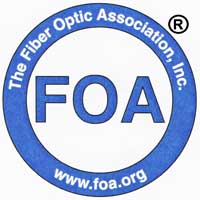

February
2021
|
Search the FOA website
FOA
Home Page Contact
Us
|
Sign
up for the FOA eMail Newsletter
Privacy
Policy
Sections
News
Technical Worth
Reading Q&A
Training/FiberU
Resoures
Safety
About
|
- In
This Issue
- Note
we have changed the format to place articles in
sections on one topic and all articles are dated so
you know if we repeat one - whcih we often do when
we think it's very important!
Why
Fiber Optic Techs Need Training
How
To Get AT&T FTTH In Your Home
How Fiber Works - New Fiber U Minicourse
Who Lost Lucent - A MUST READ
Tired of 5G, Read About 6G Instead
MM or SM FIber Continued
Newsletter
Sections
Click
on any link to jump to that section
News
Over
1million 400G Ports Shipped
TIA-568 Revisions (Updated)
Phenix Automated Connector Cleaver
SENKO MPO Tester
Technical
MM
or SM FIber Continued, Lasers & LEDs,
Patent on Fiber Optic Sensor , Loss Budget Calculator
Worth
Reading Lots
of interesting articles
Q&A
Questions from our readers
Training/FiberU
New Fiber U MiniCourses, schools, remote OTDR
for training, making training classroom safe, onine
training, materials, more
Resources
New FOA YouTube Videos. Safety
About
FOA Certifications:
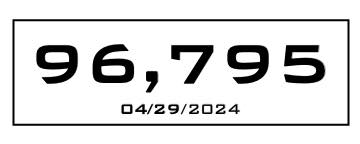
Time
To Renew Your FOA Certifications?
Special
offer - 1/3 Off Renewal
Jobs
- See
FOA Jobs
Web Page and FOA on

- The
FOA Jobs
Web Page has been updated and a new page added on Using
your FOA Training/Certification to Find the Right Job
in Fiber Optics
Where
Are The Jobs In Fiber Optics? FOA talks about all the
applications for fiber optics, what jobs involve and the
qualifications for the workers in the field in this YouTube
video.
Join
The FOA eMail Newsletter List
Want to
be notified when the FOA Newsletter is updated? Sign
up for the FOA eMail Newsletter. You can also
sign up from your cell phone: text "FOA" to 22828 (usual
text message charges apply)
Trademarks:
The FOA CFOT® (Certified Fiber Optic Technician) and
Fiber U® (the FOA online self-study program) are registered
trademarks of the FOA.

Want
to know more about fiber optics? Study
for FOA certifications? Free
Self-Study Programs are on "Fiber
U®." Looking for specific information? Here's the
largest technical reference on the web: The
FOA Online Fiber Optic Reference Guide.
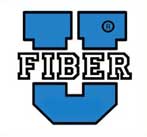
Free
online self-study programs on many fiber optics and cabling
topics are available at Fiber
U, FOA's online web-based training website.
FOA
Reference Books
Available Printed or eBooks
The
fiber book is available in Spanish and French
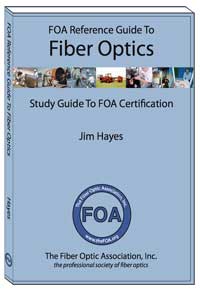
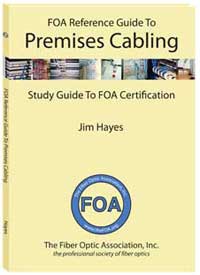
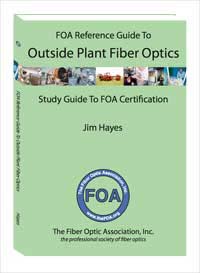
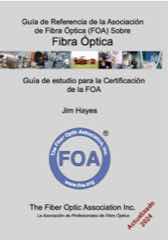
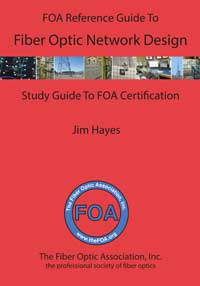
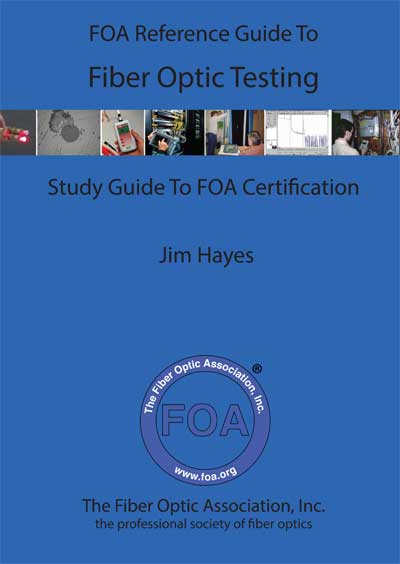
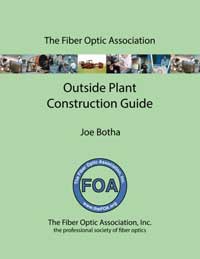
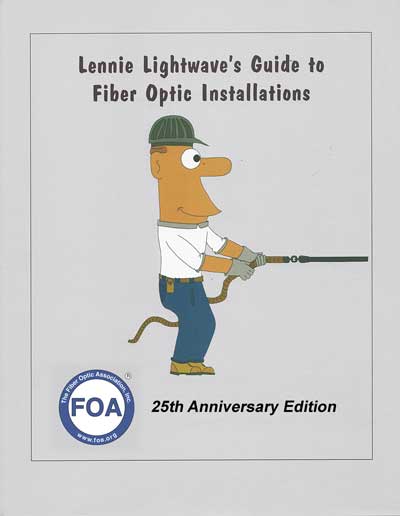
Lennie
and Uncle
Ted's Guides are now also available as free iBooks on
iTunes.
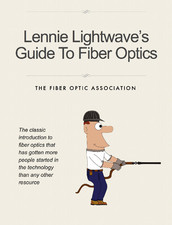
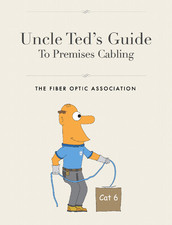
Click
on any of the books to learn more.
- Fiber
Optic Safety Poster to download and print
FOA
Videos on 
FOA
is a member of:




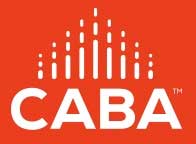
The
FOA Newsletter is edited by Jim Hayes - send your stories,
leads, ideas, comments to <jim @ foa.org>

Search
the FOA Website With DuckDuckGo
- The
Archives: Past Issues.
- Use
these links to read past issues or use FOA's
Custom Search to look for specific topics on our
website.
1/21,
2/21.
1/20,
2/20, 3/20.
4/20, 5/20,
6/20, 7/20,
8/20, 9/20,
10/20, 11/20,
12/20,
1/19,
2/19, 3/19,
4/19,
5/19, 6/19,
7/19, 8/19,
9/19, 10/19,
11/19,
12/19
1/18,
2/18, 3/18,
4/18, 5/18, 6/18,
7/18, 8/18,
9/18, 10/18,
12/18.
1/17,
2/17, 3/17,
4/17, 5/17,
6/17, 7/17,
8/17, 9/17,
10/17, 11/17,
12/17
1/16,
2/16, 3/16,
4/16,
5/16, 6/16,
7-8/16, 9/16,
10/16, 11/16,
12/16
1/15,
2/15, 3/15,
4/15, 5/15,
6/15, 7/15,
8/15, 9/15
, 10/15,
11/15 , 12/15
1/14,
2/14, 3/14,
4/14, 5/14,
6/14, 7/14,
8/14, 9/14,
10/14, 11/14,
12/14
1/13,
2/13, 3/13,
4/13, 5/13,
6/13, 7/13,
8/13, 9/13,
10/13, 11/13,
12/13
1/12
, 2/12, 3/12,
4/12, 6/12,
7/12, 8/12,
9/12, 10/12,
11/12, 12/12
1/11
, 2/11,
3/11,
4/11,
6/11, 7/11,
8/11, 9/11,
10/11, 11/11,
12/11,
1/10
, 2/10,
3/10, 4/10,
05/10,
07/10,
08/10, 09/10,
10/10,
11/10
1/09
, 2/09,
3/09, 04/09,
05/09,
07/09,
08/09, 09/09,
10/09, 11/09,
12/09
1/08
, 2/08, 3/08,
4/08, 5/08,
6/08, 7/08,
8/08, 09/08, 10/08,
11/08, 12/08
12/07 , 11/07,
10/07, 09/07,
08/07, 07/07,
06/07, 05/07,
04/07, 03/07,
2/07, 1/07
12/06
, 11/06, 10/06,
09/06, 8/06,
7/06, 6/06,
5/06, 4/06,
3/06, 2/06,
1/06,
12/05
,11/05, 10/05,
09/05, 08/05,
07/05, 6/05,
5/05, 4/05,
2/05, 01/05,
12/04
, 10/04, 9/04,
8/04, 7/04,
6/04, 5/04,
4/04, 3/04,
1/04,
12/03
, 11/03 10/03
9/03, 8/03,
7/03, 6/03,
3/03, 10/02
, 8/02, 5/02
Current Issue of FOA Newsletter
Time
To Renew Your FOA Certifications?
To keep
your FOA certifications active, you need to renew them when
they expire. Now we have a new more convenient way to renew
- an online store at Paypal - where you can quickly and
conveniently use your PayPal account or your credit card to
renew your certifications.
- You
can now renew with PayPal or a credit card
-
PayPal
is available worldwide
Join
FOA On Social Media

FOA has
four LinkedIn Groups
FOA
- official page on LinkedIn
FOA
- covers FOA, technology and jobs in the fiber optic
marketplace
FOA
Fiber Optic Training - open to all, covers fiber optic
technology and training topics
Grupo
de La Asociación de Fibra Óptica FOA (Español)
SPECIAL
OFFER - 1/3 Off Your Certification Renewal Cost
In the
near future, there will be a requirement for continuing
education to renew your FOA certifications. FOA is testing
an option for renewals where you take a short Fiber U online
course.
If you would like to help FOA test this option, you can save
1/3 the cost of your renewal. Go
here to take the Fiber U CFOT Renewal Course: |
FOA
Newsletter - Features
Why
Fiber Optic Techs Need Training (And maybe an IQ test)
Photos
and comments (edited
to protect the guilty parties) provided from the
subscriber about an installation in front of their home in
the Midwestern US.
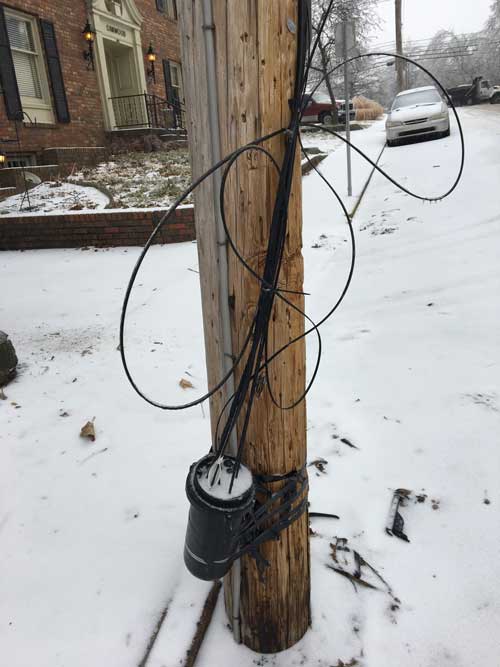
Attached are several pics of a brand new XXXXX fiber optic
junction ‘box’ installed on the utility pole across the
street from my residence here in ZZZZZ. Allow me to
describe: Clever XXXXX Technicians saw fit to locate
this box on the utility pole 2 feet or so off the ground
with plenty of excess wire lengths to provide handholds for
intoxicated YYYYY University college students to grab onto
as they stagger down the street. This fiber-optic
junction box is solidly secured to the utility pole with a
roll of common electrical tape for a sound, solid, long
lasting and secure mating of the device.
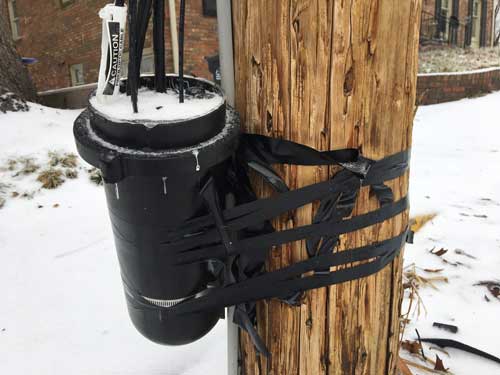
In addition, the XXXXX technicians wrapped the excessive
length around the utility pole ‘barber pole’ style rather
than re-terminate several fiber-optic connections.
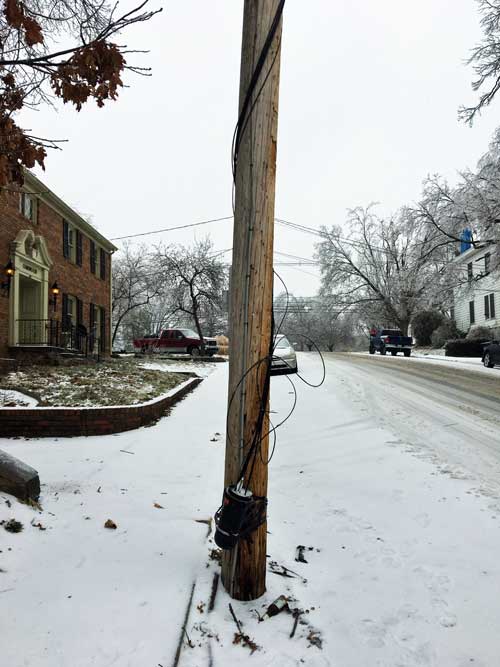
By mounting a ‘weather-proof’ splice closure upside down,
this allowed rain water to seep thru the seals at the wire
entry points and fill the box with water. Later, sub
freezing temperatures froze the intruded moisture which
expanded (as water tends to do when frozen) and separated
the fiber-optic connections inside. This resulted in
at least 3 local customers, who went out on a limb to give
the new ISP a shot, losing their service. This was
Monday Feb. 15, 2021. XXXXX's customer service
informed us that the problem would be repaired by Friday Feb
19th. A solid 4 day outage. You can thank your
intrepid highly trained installation staff for their expert
craftsmanship, skill, and foresight.
Thanks to our reader who shared these photos and comments
which were a perfect critique of this mess.If you
recognize your work here, we can suggest some free online
training at Fiber
U to start.
FTTH
Relic
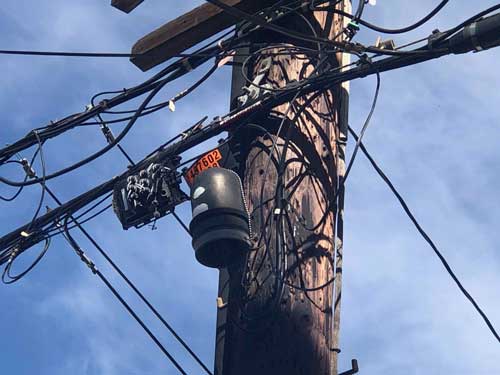
This is an original FiOS drop point in the alley behind
the building where we work for FOA in Santa Monica, CA It
was installed around 200809 by Verizon who subsequently
sold the system to Frontier. The thing to notice is the
preterminated drop box.No, not the messy pole! The drop
box has 12 ports but only 3 subscribers are connected.
That was not good for the economics of the original
system. Perhaps people just did not understand the
advantages of fiber a decade ago. There is no longer a
possibility of getting a fiber drop - we've tried.
How
To Get AT&T "Fiber To The Home" At Your Home
It's
not cheap, however. Ask Aaron Epstein of North Hollywood,
CA. Tired of his slow AT&T DSL that only promised
3.5Mb/s and sometimes was only 1.5Mb/s, Mr.
Epstein had been calling AT&T regularly for some time.
During the pandemic, he started calling them weekly.
Frustrated by the lack of response from AT&T, Mr.
Epstein placed two ads in the Wall Street Journal (below) in
the Dallas (AT&T HQ) and New York editions asking why
AT&T was treating its customers in North Hollywood so
shabbily.
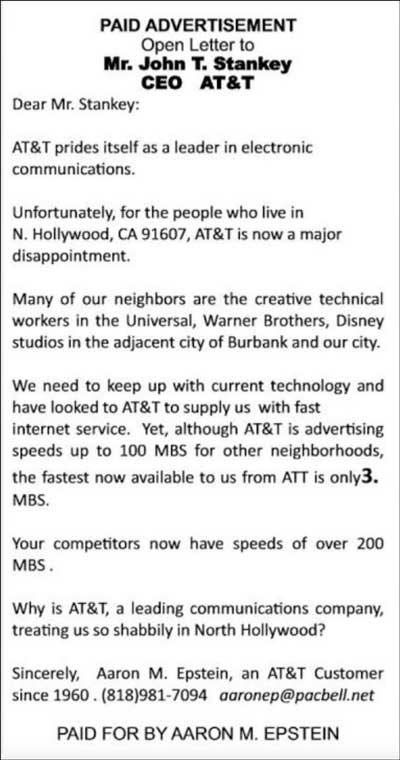
The ad was not cheap; it cost Mr. Epstein $10,000, but it
got fast results, including a call from Mr. Stankey the
morning the ad ran. The next day, two AT&T techs showed
up to start installing his fiber optic connection.
AT&T said that a network upgrade was planned as part of
an effort to bring AT&T fiber to an additional 2 million
locations this year.
But it seems if you want AT&T's attention, you need to
spend some money.
Lots of stories in the press on this: Washington
Post, The
Hill, ArsTechnica
How
Fiber Works - New Fiber U MiniCourse
Another
of the mysteries of fiber optics, like dB, is how optical
fiber actually guides light in the core of the fiber and
transmits it with low loss. FOA has several
pages in the FOA Guide on how fiber works with
animated graphics that illustrate the different ways step
index multimode, graded index multimode and singlemode fiber
work. We also have
YouTube video showing live demonstrations with a large
plastic rod simulating the core of an optical fiber.
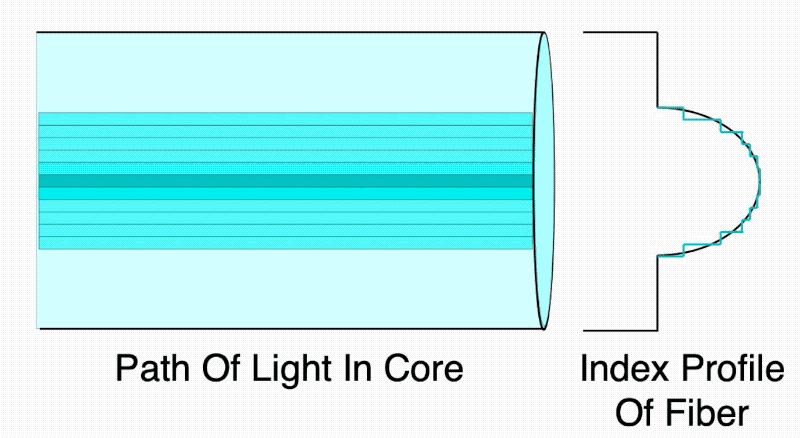
When we decides this was a good topic for a Fiber U
MiniCourse. we decided to create a new video lecture on how
fiber works. The lecture uses our usual lecture format but
with videos that animate the process of total internal
reflection and guided rays (modes) in the cores of the three
types of optical fiber.
Like all Fiber U MiniCourses, it will take you less than an
hour to complete the course and you can get a Fiber U
Certificate of Completion at the end.
How
Optical Fiber Works - Fiber U MiniCourse
If you just want to watch the video, here is the FOA
Lecture #60 - How Fiber Works
Worth
Reading: This is a MUST READ for managers in telecom or
any industry!
"Who
Lost Lucent?: The Decline of America's Telecom
Equipment Industry"
This
long and well-researched and annotated article in American
Affairs Journal should be mandatory reading for every high
level manager in a telecom company - or any other company
for that matter. To summarize the article, today, America
has no major telecom equipment company and fears the major
suppliers of equipment who are all foreign, especially the
Huawei from China. This article explains how America got
into this deplorable state.
Rather than retell the story, we'll give a few quotes
from the article:
After all, in the 1970s the two largest telecom equipment
manufacturers were U.S. companies: Western Electric and
ITT. Even in the late 1990s, the two largest were still
based in North America: Lucent and Nortel (headquartered
in Canada but employing tens of thousands of workers in
the United States).
What happened? How did America go from the world’s leader
to not even an also-ran in the span of just two decades?
Equally troubling, why did no one sound the alarm bell
when there was still time for action?
The answer lies in the fact that other nations saw the
industry as strategic and they fought to protect and
promote their own companies within this sector.
While other nations were promoting and defending their
industry, U.S. policymakers put their abiding faith in
free markets. As the U.S. International Trade Commission
(ITC) wrote in 1991, “The United States has never had a
Federal policy to promote the communications sector and is
unlikely to, given its tradition of and support for
free-market policies.”
(Do you know that both ITT and Nortel were divested from
AT&T because of pressure from the US antitrust
bureau? After divestiture, Western Electric was spun off
and renamed Lucent Technologies>)
Once Lucent was formed, Wall Street pressures became even
more intense and led to a set of ultimately catastrophic
decisions.
An even faster way to grow was to buy other companies.
Both Lucent and Nortel’s leaders were lured by the siren
song of the internet, seeing telecom as a mature business
compared to corporate data networking.
Moreover, in an effort both to cut costs and to improve
their return on assets (a key measure used by Wall
Street), both companies decided to get out of the business
of making products.
Perhaps more than any single area of government action or
inaction, a strong case can be made that it was
seventy-five years of relentless effort by the federal
government to break up AT&T that was the principal
factor in the industry’s downfall.
(Here we're only halfway through the article. Believe
me, you MUST read this article!)
The other MUST READ about this subject is one we've
referenced before:
William Lazonick and Edward March, “The
Rise and Demise of Lucent Technologies” (Paper
presented at the conference on Innovation and Competition in
the Global Communications Technology Industry, insead
Fontainebleau, August 23–24, 2007),
Tired
Of Hearing About 5G - Well You Can Read About 6G Instead
What?
What is 6G? Why are people talking about 6G when 5G is
still in its infancy?
The justification for talking about 6G is that each
generation of cell phone technology has had a decade-long
gestation period, so 6G should be here sometime around
2030, (probably before 5G is working right so vendors can
abandon it and move on to 6G?). What do we know about 6G
other than it's the next iteration of cell technology? Not
very much, it turns out, but that does not deter
technocrats from starting the hype already: 1000 times
faster than 5G, so fast that it will enable AI in the
networks. Applications you can't dream of yet. Teleportation,
maybe? That's what we reported someone suggested in
last month's Newsletter.
Somebody has even created a logo:
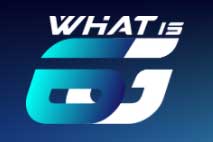
Website:
What Is 6G
Multimode
or Singlemode Fiber? Continued
Last
month in the FOA Newsletter we looked at the continuing
debate about whether one should choose singlemode or
multimode fiber for new premises networks. OSP is almost
exclusively singlemode, of course. This month, we'll add
more some data and discuss how there may be options for
utilizing older singlemode fiber at higher speeds and longer
distances. We
also have some information on a movement to use APC
connectors on MM fiber.
Read more in the
Technical section below.
FOA
Newsletter Sections
News
Technical Worth
Reading Q&A
Training/FiberU
Resoures
Safety
About
|
News
Lots
more news in Worth Reading below
|
Loon’s
final flight: After 9 years surfing the stratospheric
winds, Loon’s journey is coming to an end.
Astro
Teller
When we unveiled Loon in June 2013, we meant everything in
its name. It was a way-out-there and risky venture. Not just
fragile-balloons-on-the-edge-of-space risky, but risky at
the core of the question it was asking. Could this be the
radical idea that might finally bring abundant, affordable
Internet access, not just to the next billion, but to the
last billion? To the last unconnected communities and those
least able to pay?
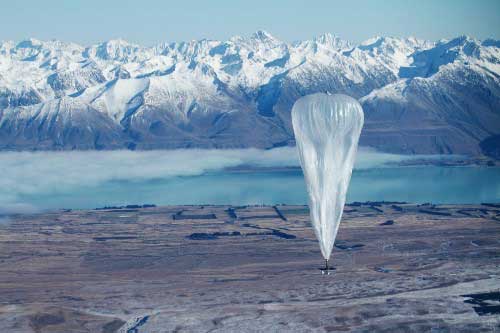 Google
photo Google
photo
Sadly, despite the team’s groundbreaking technical
achievements over the last 9 years — doing many things
previously thought impossible, like precisely navigating
balloons in the stratosphere, creating a mesh network in the
sky, or developing balloons that can withstand the harsh
conditions of the stratosphere for more than a year — the
road to commercial viability has proven much longer and
riskier than hoped. So we’ve made the difficult decision to
close down Loon. In the coming months, we’ll begin winding
down operations and it will no longer be an Other Bet within
Alphabet.
Google.X
blog entry for January 21, 2021 https://blog.x.company/loons-final-flight-e9d699123a96
Also
covered in the NYTimes
Things
To Learn From A Town That Voted Down Fiber
In last
November's election, residents of Kaysville, Utah voted down
a $22million bond issue for a FTTH network by a very narrow
margin - 8855 votes against vs. 8570 votes in favor - a 285
vote (1.6%) margin. Normally we would not pay much attention
to such a result; it happens all the time. But the value of
the bond issue caught our attention. So we did a little
research.
Kaysville
is a small town. As of the census of 2000, there were 20,351
people, 5,496 households, and 4,814 families residing in the
city. Kaysville has a total area of 10.5 square miles
(27.2 km2),(Wikipedia)
With such a small population and relatively small size, how
did they decide they needed a $22million bond issue. Based
on normal FTTH costs, one should be able to build a FTTH
network for that many homes for around $5-6million. Less if
you aren't connecting everybody, of course.
Fortunately
for those who want to understand the process of what
happened here, Kaysville has most of the relevant documents
online.
Kaysville
engaged a consulting company, Design
9, to develop a design and proposal. (Note: there is
another consulting company called Design9 in the railroad
business.) That proposal is online
here. A presentation to the city is here.
So how
did this network get to be 5-10 times more expensive that a
typical small town network? Here are some clues:
- The
network is based on 10G symmetrical GPON for most
subscribers, 10G active Ethernet for business. Most
towns have more than adequate service with regular GPON.
Slide
8 in the city presentation. Part of the reason are
their estimates of bandwidth needs of a typical home or
business (page
12 in the proposal.)
- Extensive
use of directional boring, about 3/4 of the
installation, plus some regular trenching. Directional
boring can be very expensive. When FOA interviewed a
city representative, they were unfamiliar with how
microtrenching was usually done and how it is being used
elsewhere.
- Cost:
total cost/mile of construction: ~$200,000, cost per
building passed: ~$2350, average drop cost" ~$500.
And then, the opposition was well-funded very active. They
created a website for the "Coalition for Respsonsible
Kaysville Fiber. The home page is titled "TOP
TEN REASONS TO VOTE AGAINST KAYSVILLE FIBER". (IN ALL
CAPS!) Reason #7 is, well, humorous:
7.
Fiber is old technology. While the world is increasingly
shifting toward wireless network solutions like 5G and new
satellite networks, Kaysville Fiber is doubling down on
old technology that requires a corded connection. This
fall all iPhones will have a 5G chip. In a few years your
TV and laptop will have a 5G chip. Why will we need both
fiber and a 5G connections. Soon fiber will go the
way of the corded phone. Cut cut cut! Wireless solutions
are the future for an increasingly wireless society.
That
writer must have been reading too many 5G articles that the
Washington Post labeled as "bullshit." And they don't know
that to use 5G they will need fiber into every neighborhood
anyway.
We were
told Kaysvilleutahfiber.com
was funded by private citizens first. The anti-fiber
movement was later supported by the Utah Tax Payers
Association and by inference is the incumbents Comcast and
CenturyLink. Comcast indirectly hired a former Mayor to
oppose the project.
This website published a letter
from the Kaysville City Attorney questioning the
project. (Is that a conflict of interest?)
What you can learn from this project if you are interested
in doing municipal fiber.
- Consultants
are expensive and may not provide lesser expensive
options.
- You
need to understand all the options in construction and
equipment.
- GPON
is fine. If you need 10G a few years from now, it runs
on the same fiber, even as the old GPON system continues
to run.
- Incumbents
will try to stop you, often relying on FUD - fear,
uncertainty and doubt.
Innovium
Ships Over 1 Million 400G Data Center Ports in 2020
And
that is from only one company, Innovium,
maker of Teralynx switches for data centers. With many
people working and schooling at home, 2020 was a year of
massive growth in Internet use, and higher speeds in data
centers enabled much of this growth.
“2020 was a great year for Innovium. Demand for bandwidth
accelerated across all cloud data centers driven by
worldwide growth in online businesses, 'remote everything'
and digitization efforts,” reported Rajiv Khemani,
co-founder and CEO of Innovium. “We are delighted to have
enabled cloud customers ramp their data center networks with
400G connectivity with our data center optimized and proven
Teralynx switch silicon.”
Innovium
- Read more in CI&M
BringCom
Completes Pan-African Fiber Ring Network
BringCom, a leading provider of connectivity solutions in
Africa, announces the completion of its pan-African fiber
ring network. The new fiber ring network will link
BringCom’s points of presence in East and West Africa to its
European hub in London, providing BringCom customers with
protected and reliable connectivity services.
This network expansion initiative is part of BringCom’s
growth strategy in Africa to add secure, reliable, and
diverse connectivity routes while providing innovative
services such as SD-WAN, SASE (Secure Access Service Edge),
and Edge Cloud services. BringCom’s enterprise SD-WAN
services will lower costs, increase business agility, and
improve multi-cloud applications performance. BringCom’s
SD-WAN platform also acts as a cloud connect service to
deliver complete solutions for afriQloud. afriQloud is
BringCom’s local and distributed cloud services platform
providing digital Infrastructure-as-a-service (IaaS) for
virtual data center, and virtual machine (compute) needs in
East Africa. BringCom’s operational expertise and extensive
local partnerships in Africa uniquely position the company
to deliver reliable communications services to and from
challenging environments.
BringCom Incorporated, headquartered in Sterling, VA, USA is
a leading Communications Solutions Provider operating in
Africa who has been offering high-quality international and
last-mile connectivity solutions since 1992 to international
enterprise and government customers located in the United
States, Europe, Asia and the Middle East.
Read
More.
TIA-568
Revisions: (Updated 02/2021 following TIA standards
meeting)
LC
Connector Replaces SC
BI MM Fiber Approved For Reference Test Cables
MPO
Polarity Standards Expand To 38 Pages
APC MPO Connectors For Multimode
The TIA
standard for fiber optic cabling in premises applications,
TIA-568.3, is up for its 5th revision (TIA-568.3-E) and has
many changes, most of which were expected. Three fibers,
OS1, OM1 and OM2 are no longer included although they are
mentioned as being "grandfathered," which means that these
components which have been part of the standard for decades
are now described as " grandfathered content recognized as
compliant, but not recommended for new installations."
As
usual, there are a few new definitions, some of which are
puzzling.
- A
splitter, as used in a passive OLAN, is officially
designated as a "non-wavelength-selective passive
optical branching component."
- "Optical
fiber: Any filament made of dielectric materials that
guides"
Other
changes include changing TIA fiber component standards to
comply with ISO/IEC designations; not a problem since the
TIA designations (e.g. ANSI/TIA-492AAAA, -492AAAB, -492AAAC,
-492AAAD, and -492AAAE) were confusing at best. Also added
were bend-insensitive fibers and OM5 wideband fiber. Another
change makes sense, we suppose, as all illustrations and
references to single fiber/duplex connectors are changed
from "SC" to "LC." The MPO is used as the example for
"array" or multi-fiber connectors.
MPO
Polarity Standards Expand To 38 Pages
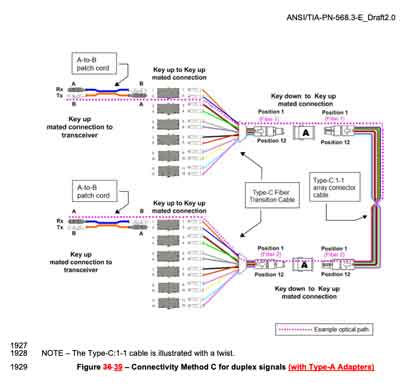
The standard contains no less than 38 pages devoted to the
MPO array connector, up from about 23 pages in earlier
editions. There are also at least 34 drawings and even more
tables. MPO is important, of course, but incredibly complex.
The MPO is the de facto standard for array connectors used
in prefabricated cabling systems and parallel optics for
multimode links over 10G. The problem is that there are 3
variations of connector/fiber polarity which leads to
multiple options for connecting various types of cables and
breakouts to single fiber or duplex LC or SC connectors.
The Type-U breakout.

There is a new breakout configuration in TIA-568.
Breakouts now come in 4 types, Types A, B, C, and now U. A
is straight through, B is all fibers reversed, C is pair
reversal and U connects even number fibers to one
connector in a pair and odd number fibers into the other
connector of the pair.
(See
the FOA page here for an explanation of MPOs.)
Editorial Comment on MPOs
The whole MPO polarity thing is very confusing. It has taken
up significant time at standards meetings for years and we
have written a number of articles about it in the FOA
Newsletter. With all the options included, there have been
impassioned pleas to add another couple of options to fiber
alignments, like the "Type-U". While I understand the desire
to have something you can call “standard”, much of the MPO
polarity info in TIA 568 seems unnecessary.
It’s like the two configurations for UTP cable, TIA568A and
TIA568B; created because AT&T said they would do what
they always do not matter what the standard.
There is no real need for 3 different configurations of
backbone cables. One can suffice because the
adaptation to various configurations is dome in breakouts or
modules. Version “A” perhaps makes the most sense because
you know which color fiber is in which pin all the time.
There is an argument for B which swaps direction on the
fibers and would be used as a patchcord between two
transceivers, but “B” can also be done with keying in
an adapter or breakouts. “C” is unnecessarily complex and
should merely be done in breakout.
We would advise anyone installing MPO backbones to only use
A cables. Knowing how people work, it is likely the backbone
configuration has been buried in documentation that no one
knows where to find. Labelling on cassettes or patch panels
should take care of identifying what fiber goes where.
Patchcords take care of the rest. Having one standard would
reduce confusion immensely.
BTW, no such standard exists for other backbone cables. A 12
fiber distribution cable terminated in a patch panel should
be organized but no standard I know says how. “Polarity” is
buried in the documentation of the actual cable plant.
But, as we know, undoing standards is well nigh
impossible!
The
complexity of the MPO explains why you might need the gadget
below.
APC
MPO Connectors For Multimode
Mentioned
during the last TIA meeting discussing TIA-568 was the
consideration of APC (angled physical contact) MPO
connectors for high speed Ethernet. A new Ethernet Standard,
400G-SR8 is considering the use of MPO APC connectors for
the parallel optics needed for multiple 50G lanes. High
reflectance is a problem in these links because the
reflectance lets light bounce back and forth in the link to
create multipath interference (MPI). Using MPO APC
connectors for MM is just as effective as SM as the graphs
below show.
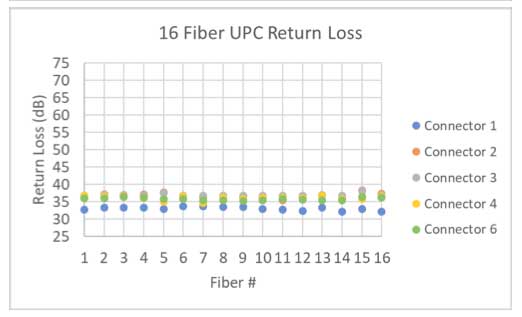
Regular MPO connectors have a return loss of around 35dB (reflectance
-35dB) while MPO APC connectors are about 25dB lower
(below).
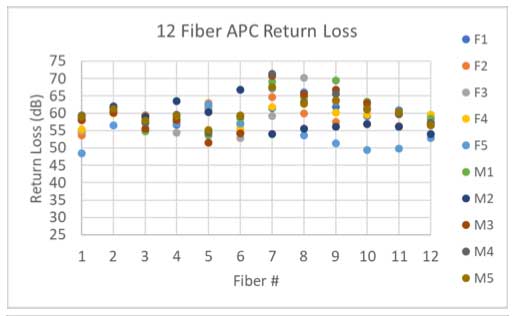
The angle used for SM APC connectors, 8 degrees, seems to
work well for MM too.
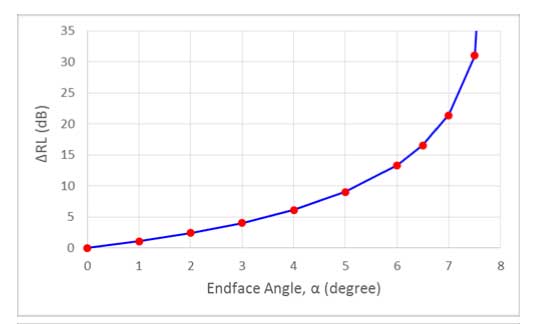
Data from: Angled
Multimode Connectors and PAM4 Signaling
E. Parsons, CommScope J. Young, CommScope
IEEE 802.3db Ad Hoc Call 25 Jun 2020
MM APC connectors are, like SM, only supposed to be mated
to another APC connector. TO identify APC connectors,
green coloring on the connector body or strain relief is
used to identify them.
New
Automated Fiber Cleaver For Connector Assembly
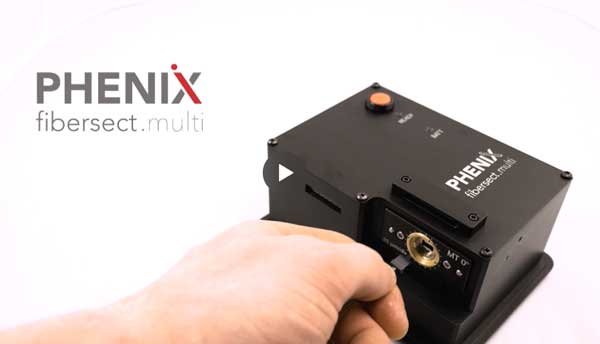
One of
the difficult parts of terminating fibers with
adhesive/polish connectors was cleaving the fiber that stuck
out of the end of the ferrule after the adhesive set. The
process had a big impact of the time and quality of the
termination process. If the fiber was cleaved too long, it
would take longer to air polish. Cleaving too short often
ended up with the cleave extending below the end of the
ferrule, ruining that connector.
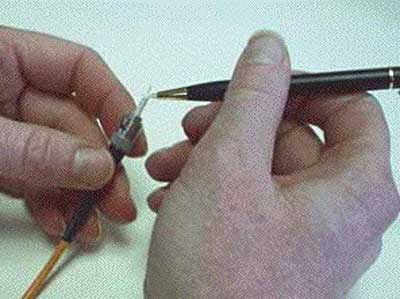 The
manual way The
manual way
This
new Phenix cleaver, aimed at manufacturing facilities dong
larger quantities of fiber optic terminations, is claimed to
quickly cut through the epoxy bead and fiber producing a
neat parallel face on the fiber that's easy to polish. It
works on all types of connectors including MPOs. For
manufacturers of patchcords, this tool can greatly enhance
productivity. It's said to be portable, so maybe field use
is possible too.
Learn
more at Phenix Fiber Optics.
Ripley/MIller
MB06 Adjustable Slit & Ring Tool
The
compact Miller® MB06 is designed to perform slit and ring
cuts on fiber optic cables, buffer tubes, and jackets from
0.05′′ to 0.25′′ (1.2 to 6.4 mm) in diameter. The tool
features easily adjustable slit and ring blades. The MB06
has two ring cut channels and a reversible V block that
improves slitting performance to accommodate the full
diameter range. As usual with Ripley Miller tools, it is
well thought out and aimed at making installation work
easier and more efficient.
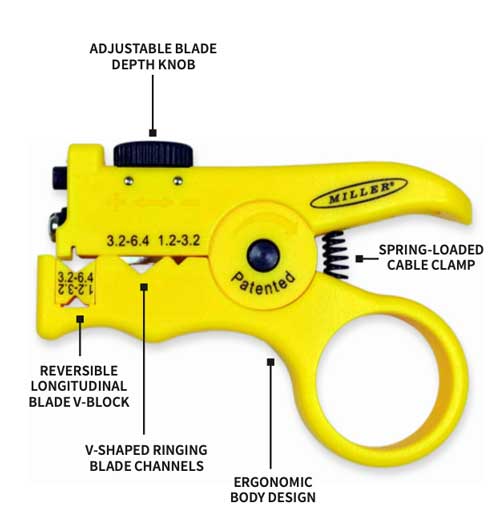
Miller®
MB06 datasheet
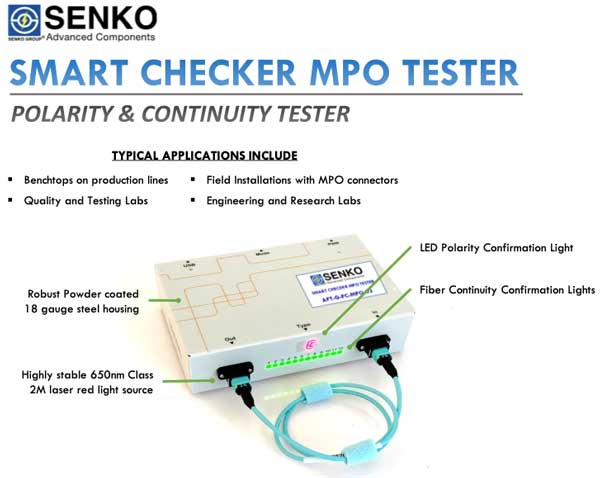
This tester verifies polarity for MPO cable assemblies and
identifies types A, B and C polarity cables. Let brian
Teague of SENKO explain it to you in their video at https://youtu.be/PoHJkkslkiQ.The
datasheet
is here.
SENKO knows about the complexity of the MPO. On this
page about MPO polarity, they say "The installer must
have deep knowledge of the equipment and their positions to
perform a correct connection."
|
Technical
On
fiber optic technology, standards, equipment,
installation, etc.
The
FOA Update Page
covers all the new technology and applications we covered
in this newsletter recently. Now you can review all that
new tech at once.

Want
to know more about fiber optics? Study
for FOA certifications? Free
Self-Study Programs are on "Fiber
U®." Looking for specific information? Here's the
largest technical reference on the web: The
FOA Online Fiber Optic Reference Guide.
|
Multimode
or Singlemode Fiber? Continued
Last
month in the FOA Newsletter we looked at the continuing
debate about whether one should choose singlemode or
multimode fiber for new premises networks. OSP is almost
exclusively singlemode, of course. This month, we'll add
more some data and discuss how there may be options for
utilizing older singlemode fiber at higher speeds and longer
distances.
Media Converters For ~$10US?
Surely that can't be true! Although FTTH OLTs are reported
to be costing about that much in some networks. But FOA has
continued to search out inexpensive components and test
them. We purchased this pair of 100Mb/s Ethernet media
converters that operated bidirectionally over one fiber from
Amazon for $23.63US. But there was a catch - no power
modules. They cost another $16 for a pair. So for less than
$40, we had a pair of 100Mb/s Ethernet media converters with
a long range.
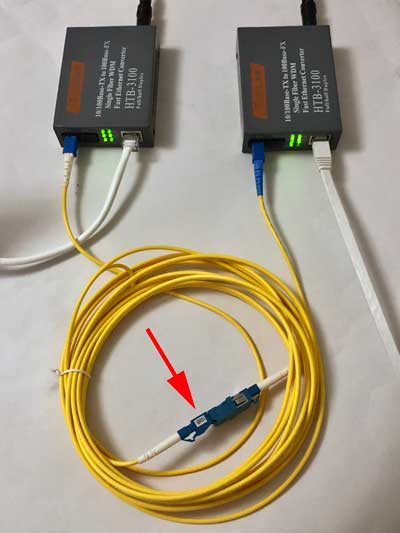
We don't understand the specifications for range, but we
tested these media converters with a 10dB attenuator (see
arrow above; also purchased from Amazon for less than
$10/pair). A link loss of 10dB corresponds to 20-25km range.
That's not a bad deal if you have a spare fiber and need an
Ethernet link on your metropolitan or utility network.
Worried about reliability of these gadgets? It's cheap
enough to have several spares available.
Using Legacy Multimode Fiber
There is lots of multimode (MM) fiber installed in buildings
and campuses that has been around for decades but continues
to provide reliable service. However, upgrading to faster
networks can be a problem because of the limited bandwidth
of early types of MM fiber. Distances on these older MM
fibers are limited at higher speeds by bandwidth, so much so
that OM1 and OM2 fibers were never specified above 10G and
have been written out of the newer TIA-568/ISO/IEC 11802
standards. Newer OM3 and OM4 fibers have been specified for
higher speed networks and OM5 is specified for CWDM (coarse
wavelength division multiplexing) to get t0 100G and above.
But if you have OM1 (62.5/125 MM) or OM2 (50/125 MM) that
old, updating it with MM fiber might not make sense; better
to make the upgrade to SM fiber instead.
But is it possible to use that older fiber?
Offset Launch Method
When Gigabit Ethernet was introduced, a 1300nm option for MM
fiber used 1310nm lasers with a singlemode launch, but
offset from the center of the core of the fiber. The reason
for the offset was the discovery that part of the bandwidth
problem with MM fiber was the index profile abnormalities in
the cores of many MM fibers. The index profile was a
step-index approximation of the ideal profile and Incomplete
fusing of the preform could cause a center dip in the index
profile (see below in this drawing from a late 1990s paper
on gigabit Ethernet in MM fiber).
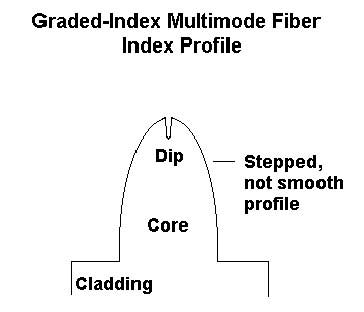
Fiber manufacturers modified their processes to remove this
problem, along with adding more layers to the core index
profile and modifying the profile for higher bandwidth at
850nm, the wavelength of the inexpensive VCSELs uses as
gigabit transmitters. Thus OM3 and OM4 fiber were created.
But using legacy fiber for gigabit transmission was also a
problem because the bandwidth of earlier MMF was optimized
for 850 and 1300nm LEDs, used in MM networks prior to
gigabit Ethernet. While using 1310 lasers should provide
more bandwidth, the center dip in the core of some fibers
made that a problem, leading to a solution of using a
singlemode fiber launch but offset from the center of the
core. Different offsets are required for 50μm and 62.5μm
multimode fibers. An offset of 17~23μm is used for 62.5μm
multimode fiber-and an offset of 10~16μm is used for 50μm
multimode fiber.
Mode conditioning patchcords are available for using
1000base-LX SM transmitters on legacy fiber. A similar
offset mode conditioning patchcord method is used in
10Gbase-LRM. However, unlike singlemode fiber where test
equipment is available to test older SM fibers for CD/PMD/SA
- called fiber characterization - there does not exist
similar test equipment and procedures for MM fiber. So the
only way to know if this technique works is to try it.
Space Division Multiplexing
Another technique used to expand the bandwidth of MM fiber
is called space division multiplexing. The "space" here is
the core of the multimode fiber and the multiplexing uses
separate modes to send different signals. It's like WDM
where you have several signals at different wavelengths, but
here it's separate modes. Considering the complexity of some
multiplexing technologies in use today, this sounds simple.
One company, Cailabs
in France, has developed this technology to a state
they claim they can multiplex 45 signals in MM fiber and
they offer products that have gained some customers. They
have some very high profile customers so one assumes the
technology works as described. But in an article
in CI&M recently, they say they can use their
technology to expand the bandwidth of MM fiber by
transmitting a "singlemode" signal down the center of a
legacy fiber. They say "A central-launch mode adapter can
elicit from a multimode fiber a propagation similar to that
of a singlemode fiber." But have they encountered legacy
fibers with the central index dip that causes so many
problems with the early applications of gigabit Ethernet?
A similar technique was used to send 1petabit/s data over
multimode fiber using space-division multiplexing. Read
the article in SciTechDaily.
SM to MM And Vice Versa
In a similar application, Panduit has introduced "OneMode-Link,"
a box that allows singlemode transceivers to use multimode
fiber at higher speeds over longer distances. According to
Panduit, "OneMode-Link is a passive media converter allowing
the deployment of 10 Gbps, and greater, using existing
multimode fibers, by eliminating modal dispersion."

The problem with mixing MM and SM fiber has always been the
high loss of mismatched fibers. There is no problem with
SM>MM, it's like aiming a hose (SM) into a bucket (MM.)
But generally going from MM to SM causes up to ~17dB
loss because of the difference in core diameters. If the
single mode launched into a MM fiber remains a single mode
near the center of the core, the MM to SM connection would
not be so high in loss.
So the Panduit unit, which sounds like it uses similar
technology to that described by Cailabs in the CI&M
article, could be a way to utilize installed MM fiber with
singlemode equipment.
The real question is whether it is cost effective to use a
passive converter like this or to just install new SM fiber.
It depends on the application.
New
Data On Using BI MM Fiber For Test Reference Cables
Recently
in the FOA Newsletter (11/2019)
we showed data from a fiber optic manufacturer, Sylex Fiber
Optics, that showed the differences in testing MM fiber with
test reference cables using both bend-insensitive (BI) and
non-BI fiber, noting the differences were small. At the
time, only non-BI fiber was specified in standards for test
leads, but in the meantime, the standards have changed so
either fiber can be used. That was a very good decision
since virtually all MM fiber is now BI and it is not
identified on the cable jacket markings. Determining if the
fiber is BI or not requires careful microscope inspection.
Recently Sylex sent us new data they had taken on LC and MPO
connectors. The LC data shows a small systematic difference
in loss, about 0.15dB higher with BI fiber reference cables,
noticeable mostly because the LC loss is so low, ~0.15dB.
With MPO connectors, the difference seems to be smaller than
the uncertainty of the measurement.
You
can read the Sylex report here.
New
Patent On Fiber Optic Sensor For Electrical Safety
A
new patent has been granted to Glen Payne for a fiber
optic cable assembly used as a sensor in electrical
cabinets to detect "arc flash" and trigger shutdown of the
electrical system. Arc flash refers to the explosive arc
that occurs when high voltage electrical circuits get
shorted out. It can be extremely dangerous or deadly for
personnel working near the circuits.
See
Getting
Electrocuted In VR Is Scary Too
The
detection method used to detect the bright arc flash
involves a bare optical fiber that captures enough light
to transmit it to the end of the fiber and trigger a relay
to shut down the power. This is an innovative way of
detecting the bright light since it is very sensitive and
immune to electromagnetic interference which is caused by
the arc itself.
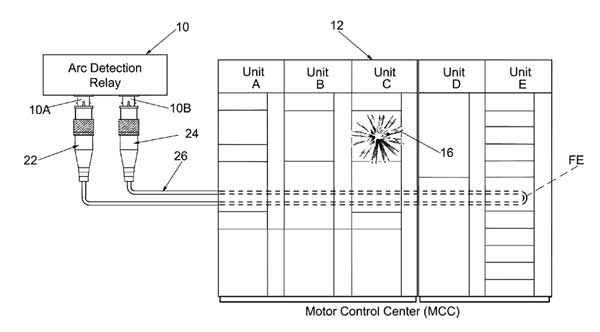
The
Payne patent (US 10,916,391) covers the fiber optic cable
assembly that senses the arc flash, making it more rugged
and flexible in application. The fiber is large in diameter,
400 microns, to increase sensitivity to the arc and a clear
tube covering the fiber protects it from damage.
Fiber
Optic Sources For Transmitters

FOA has
added a new page to its online
reference Guide on laser
and LED sources for fiber optic transmitters. The
types of sources used in fiber optic transmitters are
determined by a number of factors including the speed of
transmission and the distance needed over the link. It's
also tied to the types of fiber being used, affecting
coupling to the fiber and the preferred wavelengths of
transmission. This page in the FOA Guide covers the types of
sources and their characteristics that make them appropriate
for each application.
Sources
For Fiber Optic Transmitters - LEDs And Lasers
Midspan
Access - Simplifying Installation Of Drops
Technical
questions we get here at FOA often remind us of things many
of us take for granted that are not known by many installers
and particularly network owners and users. Recently we
received an email like this from a network owner working
with a contractor on a 15mile (25km) cable plant with
roughly 17 locations where cable drops were needed. They
were not aware of the technique of midspan access, so we
created a new page for the FOA Guide on the subject (FOA
Guide Page on Midspan Access), a YouTube
video and a Fiber
U MiniCourse.
Try
The FOA's Online Loss Budget Calculator
FOA has
written many articles about loss budgets, something everyone
involved in fiber optics needs to know and needs to know how
to calculate. We've created a online Loss Budget Calculator
that does the work for you. Just input your cable plant data
and it calculates the loss budget. It works on any device,
especially smartphones and tablets for field use and even
allows printing the results.
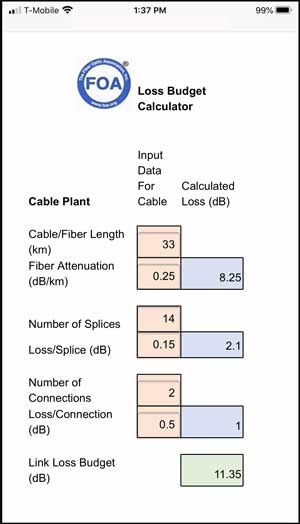
Bookmark
this page (especially on your smartphone): FOA
Loss Budget Calculator Online
Splice-On
Connector Manufacturers and Tradenames
7/2020
FOA Master Instructor Eric Pearson of Pearson
Technologies shared a list he has researched of
prepolished splice connectors with mechanical splices and
SOC - splice-on connectors for fusion splicing. This list
shows how widepread the availability of these connectors has
become, especially the SOCs and low cost fusion splicers.
Mechanical Splice
1. Corning Unicam® (50, 62.5, SM)
1. FIS Cheetah (???)
2. Panduit OptiCam® (50, 62.5, SM)
3. Commscope Quik II (50, 62.5, SM)
4. Cleerline SSF™ (50, SM)
5. LeGrand/Ortronics Infinium® (50, 62.5,
SM)
6. 3M/Corning CrimpLok (50, 62.5, SM)
7. Leviton FastCam© (50, 62.5, SM)
Fusion Splice
2. Inno (50, 62.5, SM)
3. Corning FuseLite® (50, SM)
4. FORC (50, 62.5, SM)
5. Siemon OptiFuse ™ (SM, MM)
6. Belden OptiMax?? FiberExpress (SM, MM)
7. AFL FuseConnect® (SM, MM)
8. OFS optics EZ!Fuse ™ (50, 62.5, SM)
9. Sumitomo Lynx2 Custom Fit® (50, 62.5,
SM)
10. Commscope Quik-Fuse (50, SM)
11. Ilsintech Pro, Swift® (50, 62.5, SM)
12. LeGrand/Ortronics Infinium® (50, 62.5,
SM)
13. Greenlee (50, 62.5, SM)
14. Hubbell Pro (50, SM)
15. Easysplicer (SM)
Note: There are additional manufacturers from the Peoples
Republic of China, which advertise on Amazon and eBay.
|
Worth
Reading
Each
month we read hundreds of newsletters and online articles.
These are the ones we think you will find "worth reading."
|
Worth
Reading: 02/2021
Over
1 Million 400G Data Center Ports Shipped in 2020,
CI&M. And that is from one company, Innovium,
only, maker of Teralynx switches for data centers.
HyperOne
Australian fiber backbone network planned
Lightwave “HyperOne will be a new generation of
hyperscaled network, capable of carrying over 10,000 Tbps
– more traffic than every other national backbone built in
Australia’s history combined,” according to the company's
founder.
ViaSat
drops more hints about super-capacity satellite
– Urgent Comms - and VIASAT generally delivers on its
promises. And doesn't mess up the skies with thousands of
limited capacity low-earth orbit sattelites.
Recently
in ILSR's Community Networks Weekly Newsletter -
lots of interesting reading about communities and
broadband. Week
of 2/8/2021, 2/1/2021
1/25,2021
Telecom
Industry Wants Federal Broadband Initiatives to Support
Training - Telecompetitor - As the Biden
administration considers federal broadband initiatives, 10
telecom industry associations are urging the administration
to include support for broadband skills training in those
plans.
Thinking About Changing Jobs To Telecom? Use the Philadelphia
Federal Reserve Bank's "Occupational Mobility Explorer"
Scroll way down on the lists of occupations to find several
options for telecommunications, like Telecommunications
Line Installers and Repairers to see what skills are
involved.
5G
and Wi-Fi 6 convergence crucial for smart cities and
Industry 4.0, Wireless Broadband Alliance. New
industry guidelines highlight critical role Wi-Fi will play
in the long-term success of 5G. "Operators are increasingly
utilizing the high capacity, low latency and low-cost of
Wi-Fi 6/6E to control the elevated capital expenditure
associated with 5G systems rollouts,"
Researchers
send 1petabit/s data over multimode fiber using
space-division multiplexing. SciTechDaily.
Recommendations
for a National Broadband Agenda, Benton
Institute for Broadband and Society - We need a national,
comprehensive broadband strategy, a plan that ensures that
everyone in America can use High-Performance Broadband as
soon as possible.
Low-Earth
Orbit Satellites: Great Idea but Not for Everything –
And Not Cheap. By Steven S. Ross |
Broadband Communities (And maybe as "loony" as baloons.?)
Statistics
on US Labor In Telecom
Eric
Pearson sent us some links to US Bureau of Labor Statistics
data on the US Workforce. Granted it was updated in May
2019, but has lots of useful and interesting information on
where the work is and what workers are paid.
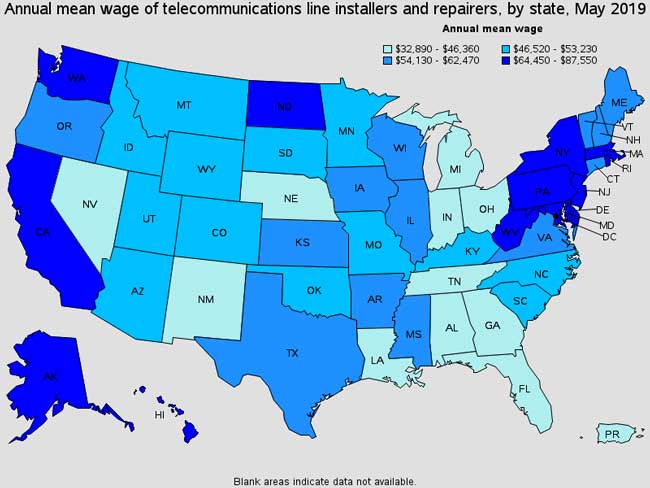
Read
the reports here:
Telecommunications
Line Installers and Repairers (Install and
repair telecommunications cable, including fiber optics.
Telecommunications
Equipment Installers and Repairers (Install,
set up, rearrange, or remove switching, distribution,
routing, and dialing equipment used in central offices or
headends. Service or repair telephone, cable television,
Internet, and other communications equipment on customers’
property. May install communications equipment or
communications wiring in buildings.
01/2021
Making
Your Town Broadband Ready Even if you are not
ready to build your own fiber or FTTH network, there are
things you can do now to be ready when you make that
decision that will also help attract private investment.
This article is by Trevor Jones, Vice President of
Marketing, Sales and Customer service for OTELCO, which owns
independent telephone companies in seven states and partners
with several community networks in Massachusetts. Contact
him at trevor.jones@otelco.com. It offers good advice for
cities thinking about or needing fiber in their town.
(Broadband Communities)
Everstream
launches 5G fiber builds in seven Midwestern U.S. markets
Business-only fiber network services provider Everstream
says it plans to launch fiber cable deployments in seven
Midwest markets to support 5G mobile network requirements.
The company says the fiber networks will help to connect
more than 2,000 macro cell towers in those markets and offer
backhaul support. (Lightwave)
Infinera,
Facebook achieve 700-Gbps per wavelength transmission on
MAREA submarine cable In a “hero experiment”
scenario, a production version of an ICE6 module enabled
wavelength transmission of 700 Gbps over 6,640 km.
(Lightwave)
Removing
Roadblocks on Bridge Over Digital Divide: Explaining the
Affordable, Accessible Internet for All Act -
Reversing laws that prohibited government or public/private
broadband, mandating "Dig Once." ILSW Community Networks
Next
Century Cities Year in Review - Overview of progress
made in the last - eventful - year. Link is to a
Black&White version which is easier to read. The color
version is here.
Telcos’
tipping point: 10G Fiber and Software-Defined Access,
Dell'Oro Group/Adtran. The need to provision and
deliver new services in a matter of hours, as opposed to
weeks or months, holds just as much priority as the
ability to deliver up to 10Gbps of PON capacity.
12/2020
Dilbert's
Company Rolls Out 5G - DON"T MISS THIS!
Passive
Optical LAN shines in Cost Comparison - Lightwave
US
FCCs Rural Digital Opportunity Fund made awards of
>$9BUS to ISPs to deliver Internet. There was
jubilation and consternation. Reading these show what we
mean:
Case
Studies - Next Century Cities - state of broadband in
some US cities.
Fiber
Resource Shortages - Doug Dawson, President of CCG
Consulting sees shortages of labor and components in 2021
Terminating
an eposy/polish ST connector - Linden Photonics
shows how to make a reliable termination (excellent
visuals show how it's done)
AFL
Splice Closure For High Density Cables - up to 3456
fibers (video)
Can
one of the architects of AT&T’s woes turn it around?
Uncool
can beat flashy tech - NY Times. Balloon Internet
project by Google's parent Alphabet hits snags, remote
areas wonder why it's needed - they have Internet on
old-tech mobile phones
Power
Delivery over Single-Pair Ethernet - TIA Webinar
recorded earlier.
Biden,
top Democrats lay groundwork for multibillion-dollar
push to boost U.S. broadband
Residents
Form Broadband Coop - “Electric
cooperatives worked, why can’t we do the same thing for
broadband?”

Saving
Lives through Education. Online, worldwide April 6-8, 2021.
The Excavation Safety Conference VIRTUAL brings critical
damage prevention education to help all stakeholder groups
online, providing new opportunities to network with industry
peers, learn safe practices, and lower costs associated with
underground damages. Register now at GlobalESCVirtual.com
Worth
Reading: 11/20
The
pandemic makes clear it’s time to treat the internet as
a utility - David Lazarus, Business, LA Times
Another
company (SpaceMobile) wants to load space with low earth
satellites - Light Reading
Chicago
And Denver Voters Say Yes to Expanded Broadband Options
- ILSR
10
Tips For Installing Fiber Optic Cable - Multilink
Why
the 5G pushiness? Because $$$. Shira Ovide, NYTimes
1995-2020
- FOA's 25th Anniversary!
As part
of celebrating 25 years of serving the fiber optic industry
as its primary source of technical information and
independent certifying body, FOA thought it appropriate to
create a short history of the organization and how it has
developed to help the fiber optic industry. We also
wanted to recognize the contributions many people have made
to the organization over the years that made FOA what it is
today.
The FOA history is now archived on the FOA website where
you can read it anytime or link to it.
Updated
info - dB, total internal reflection and science projects,
Worth
Reading - News Summary - Past Links Worth Repeating
Recycling
Fiber Optic Cable - Contact:
Steve Maginnis
LD4Recycle/ CommuniCom Recycling
(Visit
website)
sm@LD4Recycle.com
803.371.5436
If
you are interested in restoration - aren't we all? -
you should also read this article in dpPro magazine by
FOA President Jim Hayes: Damage
Protection Requies Looking Overheas As Well As
Underground - dpPRO Magazine - about the
problems with aerial cables. His previous article for
the magazine was New
Techniques for Fiber Optic Installation.
How
much fiber optic cable is manufactured each year?
CRU Reports - unsurprisingly China is by far the largest
market today
The
Institute
for Local Self-Reliance weekly newsletter has
lots of interesting articles and links.
The Open Technology Institute at New America just
published “The
Cost of Connectivity 2020,”
US
Ignite and Altman Solon issued “Broadband
Models for Unserved and Underserved Communities”
Universal
access to broadband is a cornerstone to a strong
economy, Achieving universal access will require
community partnerships. by Alfreda
B. Norman, Sr. VP, Federal Reserve Bank of Dallas
FIBER
TO THE FARM: The co-ops that electrified
Depression-era farms are now building rural internet. Be
sure to check out the high-tech equine installation
equipment.
Next
Century Cities Newsletter - News from cities
around the US including Detroit and New York plus small
Infrastructure
Get Some Respect, NY TImes "On Tech"
"The magic of the internet requires a lot of very boring
stuff behind the scenes. "
Pentagon
official: FCC decision on 5G threatens GPS, national
security
Internet
Statistics and Facts, 2020: Interesting, easy
to get lost here!
DIRT
Report On Damage To Utilities
Common Ground Alliance (CGA) annual DIRT report provides a
summary and analysis of the events submitted into CGA’s
Damage Information Reporting Tool (DIRT) for the year
2018. The complete report is available for download
here. In addition, there is an interactive
dashboard that allows users to filter the data
more by factors contributing to damages.
Structured
Cabling News - a website and weekly
newsletter about cabling.
The
Internet Master Plan for New York City.
The New York City Internet Master Plan is a
comprehensive framework for the infrastructure and
services that provide connectivity to New York City
residents and businesses. This Master Plan will guide
City actions and public-private partnerships to
transform New Yorkers’ access to this essential
infrastructure for generations to come.
Fiber
Trivia From Corning.
Why
understanding PoE now is crucial for electricians
- To ring in the new decade, IDEAL Networks is urging
today's electricians to master new skills and equipment to
cope with the growing use of PoE in intelligent lighting
applications.
Smart
City Projects: Smart city initiatives are
underway across the country. But they face funding and
technology challenges. Many cities want to upgrade
infrastructure to improve resident experience, safety and to
generate revenue.
The
Future Of Work Is Skills - So Stop Worrying About
Degrees - The
reality is the future of work is about skills, not just
degrees. (FOA Newsletter Feb 2020)
Want
a White-Collar Career Without College Debt? Become an
Apprentice (NYTimes)
Apprenticeships probably began with the first jobs, where
young people work under experienced craftspeople to learn
a trade. In the last century, they became more organized
under labor unions like the International Brotherhood of
Electrical Workers, one of the FOA's oldest and biggest
approved school systems. Today, apprenticeships are
expanding as young people look at viable alternatives to
loading themselves with debt while attending college.
The
job market is hot. So why are half of U.S. grads
missing out?
VIAVI
Books On Fiber Optic Testing (2 volumes) - They're back!
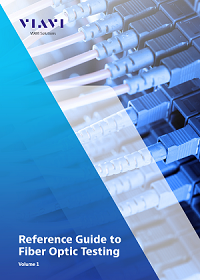
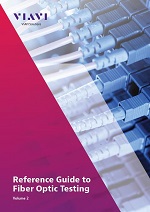
Besides
the FOA reference materials, two JDSU/VIAVI textbooks,
Reference Guide to Fiber Optic Testing, Volumes 1 and
2, were used as references for some of the FOA courses
and are recommended for instructors and students. The books
are available from VIAVI as eBooks and the everyone should
download them and recommend them to others.Download yours
now. Volume
1. Volume
2. Viavi Books
Guidebook
To MPO Testing OptoTest
offers this complete guide to MTP®/MPO testing. In this
guide, you will learn all there is to know about the
different test methods, equipment options,
troubleshooting, and best maintenance practices to ensure
that you have the best testing experience.
Go
here to download the book.
50th
Anniversary of The Development of Low Loss Fibers
A history of the development of low loss fiber, a
fascinating story by Jeff Hecht on the OSA (Optical Society
of America) website.
How
OFS Makes Fiber
Interesting YouTube video on how fiber is made. Perhaps a
little too much "show biz" but fascinating. If you have ever
seen fiber manufacture, look at this video. You will be
amazed at how big preforms have become!
How
Nexans Makes Copper Cables - compare the process
to fiber - don't most of the machines look similar?
The
True Cost of Telco Damages (what backhoe fade or
target practice can cost)
Rural
Electric Cooperatives: Pole Attachment Policies and
Issues, June 2019.
Clearfield-FOA
Certification Training Clearfield is now
offering their customers an FOA
CERTIFICATION course. This course provides
a basic understanding of fiber optic technology, as well
as Clearfield product knowledge and how Clearfield’s
integrated product systems work together in a fiber
network.
Substandard
Contractors - Fiber Optic Knowledge Doesn't Always
Trickle Down (EC Mag)
Another
Source Of Articles On Fiber
FOA
President and editor of this newsletter Jim Hayes has also
been writing a column in Electrical
Contractor Magazine for almost 20 years now.
Electrical contractors do lots of fiber work and this column
has covered some topics they are interested in including
installation processes, network design, fiber applications
and a lengthy series on dark fiber - what it is, how's its
used and how it benefits the growth of communication. A
recent web site redesign makes it easier to browse all these
articles - just go to http://www.ecmag.com/contributing-authors/jim-hayes
and you can see all of them. |
Q&A
Tech
Questions/Comments From FOA Newsletter Readers Worth
Repeating
The
FOA Fiber FAQs
Page (FAQs = frequently asked questions) gathers
up questions readers have asked us (which first ran in
this newsletter) and adds tech topics of general
interest.
|
Good
Question!
The
FOA Fiber FAQs
Page (FAQ s = frequently asked questions) gathers
up questions readers have asked us and adds tech topics
of general interest.
Questions
From FOA Newsletter Readers
February 2021
Documenting
Test Results
Q: We’re currently working on a bid that includes
presenting some test sheet documentation for OTDR &
Light loss testing. What should I do?
A: High end LSPM or OLTS should store data and have
some software to report test results. Simpler units should
simply require logging data into a spreadsheet showing Cable
ID, Fiber ID, wavelength and loss. Details like launch &
receive cables and test results can be kept separately on
the spreadsheet. Today’s OTDRs will show you a trace and an
event table that lists each even in the fiber tested as well
as overall loss. Whatever OTDR you use should have software
for reporting test results. Here is an example of a report
from an EXFO and a trace from a Yokogawa.
Installing Cable
Q: Below are specs for an installation. We’ve never
installed a Fiber Optic run this long. Please see below
questions and info.
-Fiber Optic cable to be used is a 24 strand Single Mode
application
-Length of run is 7200 m long
-Appears that all the Fiber is on one reel. However do you
recommend having some junction points on pedestals along the
way for testing-maintenance purposes or just one continuous
run if possible?
A: FOA has lots of information to help answer your
questions:
Re underground installation. See https://foa.org/tech/ref/OSP_Construction/Underground_Construction.html
and https://foa.org/tech/ref/OSP_Construction/Underground_Installation.html
in the FOA Guide.
There are other questions you need to ask:
Are there no intermediate connections or drops required?
It’s just one straight fiber run? You should be able to
install it continuously.
What is the installation type? Pulled in conduit or direct
burial?
If pulled in conduit and you can pull in one try, that’s
best. You should use a pulling capstan to limit tension,
attached to the cable with a breakaway swivel pulling eye
and use lubrication. Use the American Polywater guides (https://www.polywater.com/product/polywater-f-fiber-optic-pulling-lubricant/)
for choosing lubricant and decide if you need an
intermediate pull.
Direct burial is simple for a long run, just ensure you have
the proper equipment.
January 2021
Maintaining
Dark Fiber
Q: Do you have any standards that speak to how often
dark fiber should be tested with OLTS and OTDR? Such as just
at installation and when troubleshooting, or should they be
done on a regular basis?
A: We at FOA know of no standards calling for
periodic testing of fiber optic cable plants.
Fiber optic networks generally do not require maintenance
and it is often detrimental to the network. It is the
opinion of FOA and most people in the industry that testing
should be done upon completion of the installation and data
submitted to confirm proper installation of the cable plant.
Data should then be stored for reference in case of problems
requiring troubleshooting or when new dark fibers are turned
up. Before lighting a dark fiber, it should be tested and
the results compared to earlier data. Since both tests have
some uncertainty, test results can vary as much as 0.5dB on
short cables, higher on longer runs.
If older fiber is being upgraded to higher speeds, now
cities like Santa Monica where we live are upgrading to 100G
networks, fiber characterization including chromatic
dispersion, polarization mode dispersion and spectral
attenuation (for DWDM) are advised. Of course, every time a
connection is opened, it should be inspected and cleaned.
And patchcords should be tested; even new ones in sealed
packages are often dirty. There is a reason people call the
plastic protective caps on connectors “dust caps!”
Otherwise, with fiber, we suggest the patch panels be locket
to keep unauthorized personnel from accessing them and
causing problems. Even disconnecting a connector can add
dirt to the connections and cause problems.
December 2020
Are FOA Videos and Web Up To Date?
Q:
Are the videos on YouTube still relevant by today's
standards are are they out of date?
A: Excellent question. We’ve discussed this within
the FOA many times.
For example the live action videos on cable preparation,
termination, mechanical and fusion splicing and testing are
quite old by tech standards but the processes have not
changed in two decades. Preparing loose tube, armored or
tight buffer cables has not changed in over 20 years, nor
has adhesive/polish connector termination.
Prepolished/splice connector and SOC process are different
and those processes have been updated. Testing processes are
the same with the main difference being the automating of
OTDR testing. Manufacturers have dumbed-down OTDRs so well
that it seems few techs know how they work or how to read a
trace, evidenced by the results of the FOA CFOT
Certification exam where questions on OTDRs are the most
often missed.
We just did a review of the copper installation for the
Premises cabling (CPCT Certification) and that has not
really changed in three decades - since the introduction of
Cat 5 cable!
We review and update the technical pages in the FOA Guide
all the time. Look at the Table of Contents (FOA Guide-https://foa.org/tech/ref/contents.html)
and see how many pages have the NEW symbol, indicating
updates in the last couple of months.
Also FOA is adding YouTube videos (https://foa.org/tech/ref/contents.html#YT
) and Fiber U MiniCourses (https://fiberu.org) on many
topics regularly - monthly this year, covering new tech and
the topics we know are lesser-known or new to most techs.
And let us know if there are topics you think we should
focus on in the future.
Microscope Power For Connector Inspection
Q: What
power microscope do you recommend to inspect
singlemode/multimode in 1.25/2.5 format (ST, SC, LC)?
A: Microscopes
in the range of 100-400 power are available. Many people
assume higher power is best - and it is for examining
polishing results in the center of the ferrule - but lower
power helps inspect more of the ferrule for dirt when used
in the field before connecting or testing cables. We prefer
the lower power.
So for patchcord manufacturers, 400, field techs 100.
Patchcord manufacturers will undoubtedly use video
microscopes, most field tech the optical ones.
November 2020
Loss For APC vs UPC Connectors
Q:
I was wondering if there will be a standard connector loss
for a UPC connector and a different lower value for an APC
connector.. ex. upc has 0.5dB while APC is 0.3dB.
I would like to make all connectors uniform on a new network
infra to avoid mismatch and causing any possible damage on
the equipment when APC will be plugged into to a flat.
A: There is really no statistical difference between
APC and UPC connector loss. The lower reflectance of the APC
actually reduces loss since the reflectance represents a
factor in connection loss, This issue of connector grades
has been discussed at international standards committees for
years. ISO/IEC wants to have grades of connectors, rated for
connector loss in ranges from 0.1 to 1dB, but I do not think
it’s standardized. I recommend using 0.3-0.5dB for loss
budgets, where in OSP networks it matters little, since
there are only a few connections and fiber and splice loss
is a larger factor.
Keeping UPC and APC connectors straight is easy - APCs are
Green, UPCs are blue. Everybody just needs to be taught
that!
OTDRs - Launch Cables And Range
Q:
I have a question about OTDR launch cables. In
all readings about OTDR testing, it states that the launch
cable "needs to be of sufficient length ...". What
length is sufficient? How long should a launch cable
be? What is the maximum length of cable plant that can
be tested at one time?
A: OTDR launch cables need to be long enough to allow
the OTDR to settle down after the test pulse leaves the
instrument and reflectance at the output connector overloads
the receiver. The dead zone is a function of the OTDR test
pulse and the condition of the output connector. If you are
testing short cables (<1km) with very short test pulses,
a launch cable can be 20-50m long. If you are testing a very
long cable with very wide pulses (some OTDRs have pulses
~4microseconds long, equivalent to ~1km) you would need a
2-5km launch cable. So the answer to that question is it
depends on how long the fibers are you are testing.
As to how far a OTDR can reach, the answer is generally not
specified in km but in dB. The best OTDRs have a reach of
~40dB at 1550nm which corresponds to ~150-200km, spending on
how good the splices are. That length of fiber would have
~30 splices for say 3dB splice loss.
Here’s the FOA
Guide page on OTDR testing and the FAQs
page Frequently Asked Questions about OTDRs.
October 2020
Last month's article about the installation
of a 6912 fiber cable in small conduit prompted a
number of this month's questions on social media. And there
were more too.
Re: Installation
of a 6912 fiber cable
Q: For this post, "Tight Fit: 6912 Fiber Cable
Pulled in 1.25 inch Conduit”, he asks if they can see one
end completely terminated?
A: It takes about 2 full racks of patch panels or one
rack of splice trays. Sumitomo shows the splicing rack here
https://global-sei.com/data-center-solutions/splicing-rack.html.
Most systems using these cables will buy fully populated
patch panel racks with a splice rack for the cable to splice
to 6912 fibers terminated in the rack.
Q: And a second question:: How long does it take to
terminate? And over how many panels?
A: A very experienced tech can splice one of these
cables in ~75-100 hours using ribbon splicing.
Q: I assume that's smaller fiber like 80 micron
cladding
A: All the fibers in the high fiber count cables are
made with regular singlemode fiber - 9/125micron. TO make
the cables smaller, the buffer coating diameter is reduced
to ~200microns to make the fibers smaller.
Q: How was it prepared with the splice tray and ODF?
It might require a dedicated panel and splice tray.
A: It takes about 2 full racks of patch panels or one
rack of splice trays. Most systems using these cables will
buy fully populated patch panel racks with a splice rack for
the cable to splice to 6912 fibers terminated in the rack.
Q: Is this an actual photo or was the cable installed
in a different type conduit.
A: We were told that is the actual size of the cable
and conduit although not of the actual installation
discussed.
Q: What is the minimum bend radius of that cable?
What procedures did they use to maintain that bend radius
through those 90 degree curves?
A: The minimum bend radius is 15X the cable diameter
for that cable (diameter 1.14” or 29mm), about 17” or
435mm. The conduit bends had to be controlled to be larger
than that radius.
Jobs In The Movie Industry
Q: Does anyone know if there are job positions in the
film industry that involve fiber optics? I started out
working in film with audio work with some camera as well. I
eventually transitioned into fiber optics installation and
testing. I've been trying to find out if there's a way to
find work that combines the two.
A: There are certainly jobs for fiber techs at the
film studios. We worked with a group 20 years ago to find
dark fiber in LA to connect studios to sound stages and
other facilities. Every studio now has fiber connections
everywhere, like this one at Paramount (below). I don’t know
where to look for jobs, but I’d guess it would be through
the unions - who represents the techs for the cameras,
monitors, etc.?
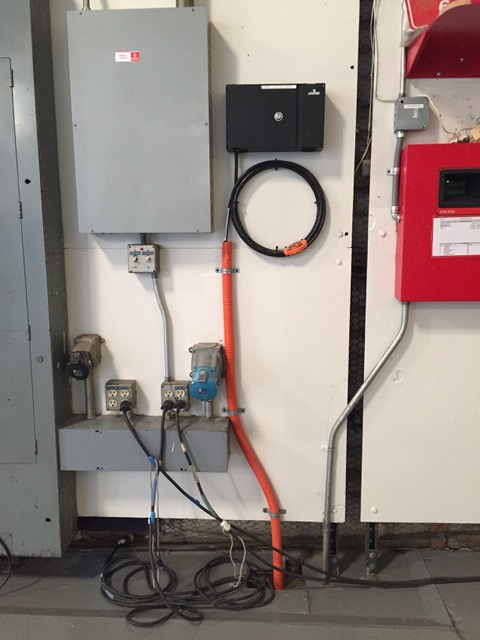
Preparing Cable For Splicing
Q: Is there any standard on the preparation length of
strip jacket upto the splice tray. Ideally its better to
have a loop of buffer before getting into the tray if ever
the closure has enough space for slack.. its also nice to
put some hose to the buffer to add on protection. So far, i
don't see any standard and can't support the remarks on what
to follow. The practice was to take note on macrobend and
have enough length of fiber to reach the machine.
A: There is a lot of variation in the size, shape
and design of splice closures, so the length varies
according to the closure and trays. For loose tube cable,
the length of buffer tube from the entrance to the splice
tray and the length of fiber needed in the tray are given in
the directions for that splice tray. Similarly for ribbon
cable, but the variations in ribbon cable designs often
requires special handling and sleeving for the ribbons. Most
manufacturers have specs available online.
Fusion Splice-On Connectors (SOCs) (From an FOA
Instructor)
Q: A question came up from one of our students
regarding splice on connectors. Is there a TIA or
other standards body that addresses this issue? We are used
to the 0.75 dB loss for a mated pair, however, when this
mated pair has two fusion splices that terminate the
connector, is there a recommendation?
One could make the argument that it does not make any
difference as the other alternative is splicing a pigtail
for termination of a cable. This pigtail splice is
normally included in the link loss budget
calculation. So similarly, with a splice on
connector it is the same as splicing on a pigtail.
A: There are no specific TIA or IEC specs that
address these splice-on connectors or pigtails. If you used
TIA numbers and included the splice and connector it would
be 1.05dB - 0.75dB for the connection and 0.3dB for the
splice, that’s mated to a factory adhesive/polish
connector. Or if it were two similar connectors,
1.35dB.
Everybody, including the people in TIA standards groups,
know those numbers are too high for most single ferrule
connectors. They keep them at 0.75dB for prepolished/splice
connectors (w/ mechanical splices) and array connectors
(MPOs) which have somewhat unpredictable performance.
Internationally, IEC has created grades of connectors from
~0.3 to over 1dB. The newer mechanical splice connector kits
now use the Chinese copied cleavers which are super - at
least the few we have tested - and the connectors are now
much lower loss and consistent.
SOCs (fusion splice-on connectors) are spec’ed as the total
termination and are generally just as good as the typical
adhesive polish connector - 0.5dB is plenty of margin for a
those mated to a factory adhesive/polish connector.
Spliced on pigtails are generally considered a termination
and the splice is not broken out - like a long SOC. But I
cannot guarantee everybody thinks that way. But a fusion
splice is typically <0.1dB anyway.

The
word on the "Dig Once" program is getting out - FOA is
getting calls from cities asking us for information and
advice. Here are some links:
The DoT page on the administration’s Executive Order: http://www.fhwa.dot.gov/policy/otps/exeorder.cfm
From the Council of State governments: http://www.csg.org/pubs/capitolideas/enews/cs41_1.aspx
From the city of San Francisco: http://sfgov.org/dt/dig-once
An article about Dakota County, MN: https://muninetworks.org/tags/tags/dig-once
And
the one to download and hand out:
A “How To” Guide from The Global Connect Initiative: https://share.america.gov/wp-content/uploads/2016/04/6.-GCI-Dig-Once.pdf
Fiber Optic Cable Plant - The Finished Product 4/2020
In
April, FOA received inquiries from several sources that all
deal with the same subject - what is involved in the
specification and acceptance of a cable plant at the end of
a installation project. And what are reasonable
specifications for a cable plant.
FOA has a lot of documentation on a project involving
designing and installing a cable plant in the
FOA Online Guide and our Textbooks, but the acceptance
process has usually been relegated to a few paragraphs. We
decided to add a page
on project "Deliverables" in the FOA Guide that covers
this topic in more depth. This page looks at a project, goes
into some depth on loss budgets and includes links to FOA
tech documents to help you investigate further.
Correction: In the article, the original list of fiber
specs for G.652 was wrong. It should be 0.4dB/km @ 1310nm.
Deliverables
in the FOA Guide
Is
There A Standard For Fiber Optic Installation?
Another
question we get often is "Is there a standard for fiber
optic installation." The answer is yes, but not from the
usual standards groups you might expect. Over 20 years ago,
the National Electrical Contractors Association (NECA) asked
FOA to help create a standard for installation. That
standard, ANSI/NECA/FOA-301 has been updated three times
already and is about ready for another update.
Unlike most of those groups who charge you a fortune for
standards, FOA covers the cost so ANSI/NECA/FOA-301
is available free from FOA.
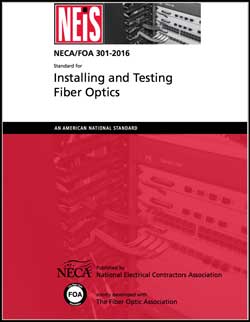
Download
your free copy of ANSI/NECA/FOA-301
here (PDF)
Older
questions are now available here.
|
Training /
FiberU
News and resources to help you learn more and stay
updated.
Find
a listing of all the FOA-Approved schools here.

Free
online self-study programs on many fiber optics
and cabling topics are available at Fiber
U, FOA's online web-based training website.
Free
online training at Fiber U
The
FOA has >100 videos on  |
More
New Free Fiber U MiniCourses
How
Fiber Works
Another
of the mysteries of fiber optics, like dB, is how optical
fiber actually guides light in the core of the fiber and
transmits it with low loss. FOA has several
pages in the FOA Guide on how fiber works with
animated graphics that illustrate the different ways step
index multimode, graded index multimode and singlemode fiber
work. We also have
YouTUbe video showing live demonstrations with a large
plastic rod simulating the core of an optical fiber.

When we decides this was a good topic for a Fiber U
MiniCourse. we decided to create a new video lecture on how
fiber works. The lecture uses our usual lecture format but
with videos that animate the process of total internal
reflection and guided rays (modes) in the cores of the three
types of optical fiber.
How
Optical Fiber Works - Fiber U MiniCourse
Reading
OTDR Traces
The second course this month covers one of the topics most
missed on CFOT certification exams - Reading
OTDR Traces. It's all about what elements are
displayed in an OTDR trace and what they represent. It's a
very different format from other Fiber U courses. OTDR
traces are visual, so it's a visual course where you learn
by "pointing and clicking" on a simulated OTDR trace, like
this:
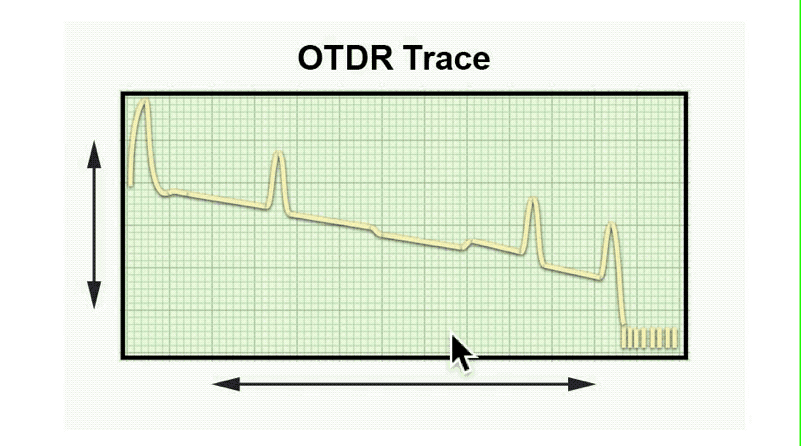
Midspan
Access
As promised last month in our tech article on midspan
access, we took the new material created about Midspan
Access in fiber optic cable installation and
made that into a minicourse. This technique is fairly
widely used because it saves much time and cost in adding
drops to a fiber optic cable, but we've been surprised how
many techs are not familiar with it. The MiniCourse takes
only a little time, about right for a coffee break.
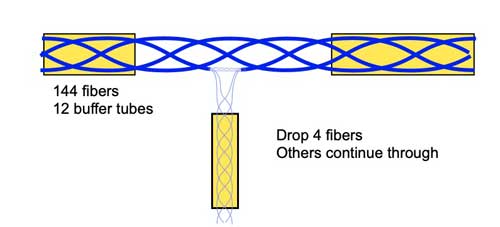
That makes 10 Fiber U MiniCourses, 5 Basics courses, 4
Skills courses, 1 Design course and 6 Applications courses -
26 free online self-study courses for everyone. And we have
lots more planned for the near future.
All Fiber U courses are free but there is a
nominal charge for the tests for a Certificate of Completion
to cover the cost of the online testing site we use. Most
online courses cost hundreds or thousands of $US, so we are
sometimes asked how FOA can offer free courses. The answer
is we have very low course development costs since we use
the FOA Guide's pages (almost 1,000 of them) and Videos
(over 100 on YouTube) and the courses are completely
self-study - no instructor to guide you and provide feedback
on your work. (And we do not track you.)
The Fiber U course method has been around for over two
decades and used by tens of thousands of people to
learn more about aspects of fiber optics or prepare for
their FOA certification exams. Since the reference material
for Fiber U is the same as used for training for FOA
certifications and for the certification exams themselves, Fiber
U courses are the ideal study guide for FOA
certifications.
More
New Fiber U MiniCourses

Got
An Hour Or Less? Learn Something New About Fiber Optics.
FOA has
introduced a new type of Fiber
U
course, the MiniCourse, a free online course you could take
in a short time, perhaps as you ate lunch at your desk or
took a coffee break. The
topics of these courses should explain what they are about,
and these are all very important topics to fiber optic
techs.
Fiber
Optics In Communications
Fiber
Optic Network Restoration
Fiber
Optic Connector Identification
The
Mysterious dB of Fiber Optics
Fiber
Optic Cable Bend Radius
Fiber
Optic Link Loss And Power Budgets
Fiber
Optic Connector Inspection And Cleaning
Fiber
Optic Media Conversion
Fiber
Optic Cable Midspan Access
Reading
An OTDR Trace
The courses have two components, video lectures and
readings, that are complementary. As usual there is a
self-test to allow you to check your comprehension. As with
other Fiber U courses if you desire, you can take a short
test for a Fiber U Certificate of Completion that costs
only $10.
All these free courses and many more are
available at Fiber
U.
New
FOA Schools
Welcome
School
386 Peabody HS (program in conjunction with RCN)
What
Fiber Techs Don't Know -
What
We Learn From FOA Certification Tests
As FOA
moves more testing over to our digital online testing system
at ClassMarker, we have access to more data about our
testing, including what questions and topics on the tests
are answered incorrectly most often. Having this data gives
us an opportunity to evaluate the questions and how they are
stated, but more importantly it allow us to help our
instructors teach the subjects and us to change our
curriculum and online courses to emphasize these particular
topics. These are some of the topics that we have noticed
are answered incorrectly more often in FOA and Fiber U
tests.
Most of the questions missed are on testing.
1. OTDRs - particularly what information is in the OTDR
trace.
2. The difference between dB and dBm
3. Loss budgets - both the concepts and doing the math
4. Insertion loss testing - single-ended or double ended for
testing patchcords or cable plants, how to set 0dB
references
5. Units of measure - fiber is measured in microns,
wavelengths in nanometers, etc.
At FOA, we're working to add Fiber U
MiniCourses on these topics and working with our
schools to emphasize these topics in their classes.
If you are going to be taking a FOA certification course or
test in the near future, these topics should be on your
final exam study list.
What We Learn From Hands On Labs
We learn about students performance in hands-on labs from
the feedback of our instructors and our own experiences too.
One big problem is the use of hand tools. Growing up today,
you learn how to use keyboards, mouses and touch screens,
but decades ago, you also learned how to use basic hand
tools. This is big enough of a problem that we're
considering adding some video lessons on basic hand tools to
prepare students for cable prep, termination and splicing
that require the use of hand tools.
FOA
"Work-To-Cert" Program
Experience
Plus Online Study At Fiber U = FOA Certification
This
year, more techs have become comfortable with online
conferences, webinars and training. Many have discovered
that they can become FOA Certified using their experience in
fiber optics and study for the FOA certification exams
online at Fiber U.
Thousands
of industry professionals have applied to the FOA directly
for certification without the need for classroom training,
based on their knowledge and skills developed working the
field. Since FOA certifications are based on KSAs
(knowledge, skills and abilities), current techs already
show the skills and abilities required through their field
experience. FOA provides free online self-study
courses at Fiber U
for the knowledge part to prepare you for FOA certification
exams which you can also take online.
If you are an experienced field tech interested in
certification, and FOA is the internationally
recognized certifying body for fiber optics, you can find
out more about the FOA
"Work to Cert" program here.
If you are already a CFOT, FOA also offers many specialist
certifications you can obtain based on your experience as a
field tech. See what's available at Fiber
U.
Options
For Training Classes -
Social
Distancing and Masks
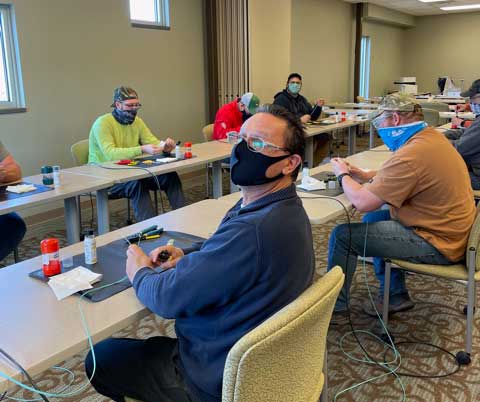
Outdoors
(11/2020)
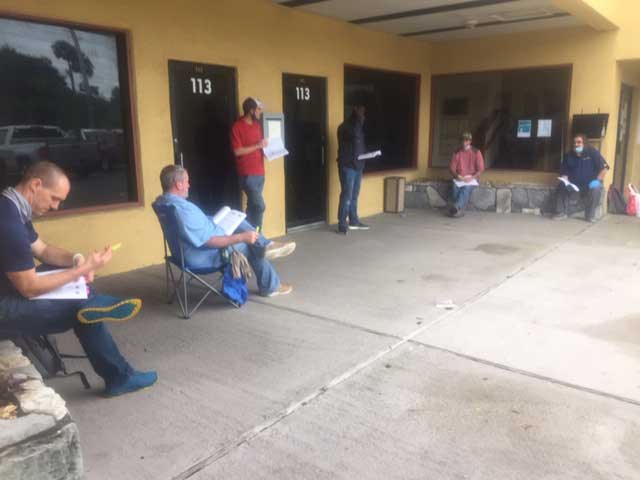
Tom
Collins, Techtricians, FOA Director, keeps exploring new
ideas for training. This time, the course moved outdoors in
Daytona Beach, Florida. This solution works well as long as
it's warm and dry!
New
Approach To Fiber Optic Labs - Sharing Test Equipment
(10/2020)
Tom
Collins, Techtricians, FOA Director
Techtricians,
a FOA approved school, has taken a new approach in
how we provide lab training. Fifteen years ago, we developed
a hybrid training model had the participants complete online
(remote) lessons with face to face labs. Over the past 12
years trade organizations, colleges, vocational, vendor
training, and trade apprenticeships have adopted this model.
At the beginning of the pandemic we spent a lot of time,
energy, and money developing remote labs. We have
incorporated lessons learned from that process to restart
safe face to face labs.
First, we provide disposable materials and PPE’s for all
learning. Every student has their own work space with 8-9
feet of separation and their own set of hand tools only used
by the student. All of the classroom information is accessed
online or with USB drives. Our biggest challenge was how to
safely share testing equipment so every student could have
the practical hands on experience.
We believe we have found that solution with the help of “ezremote”.
The ezremote allows a multitude of students to have
practical exposure and experience with using a video
microscope, OLTS and OTDR testers. Every student can access
the remote via their own iPad or their smart phone, see
below picture and movie.
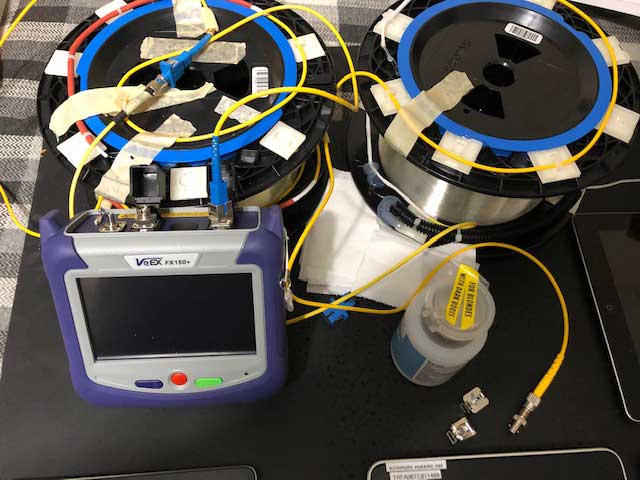
The VeEX OTDR set up for remote access in class
Recently, we contacted PCS, Inc. which is a premiere
manufacturer’s representative firm serving the Southeastern
US since 1974. Headquartered in Roswell, GA, Marc
Wright a sales representative spent a lot of time and
energy helping Techtricians to purchase the VeEX
FX150+ device. It is a full featured Mini OTDR with
high resolution sampling and intelligent link mapping for
Metro, Access and FTTx networks remote application. The
compact, lightweight platform incorporates built in WiFi,
power meter, light source, fiber inspection probe and VFL
test options which add exceptional versatility to the unit.
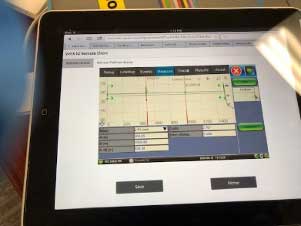 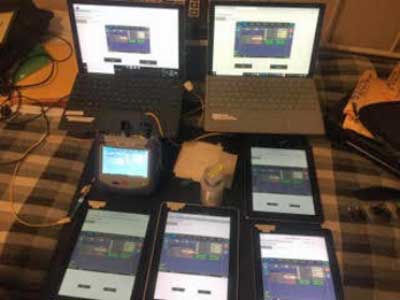
The remote OTDR displayed on an iPad (L) and on 4
smartphones and 2 laptops
In September we completed our first trial in a face to face
lab session in Lake Mary, Florida. The OTDR unit uses a WIFI
connection. The students went to the VeEX website with their
iPad or their smart phone and connected the to the base
unit. The lab module used one OTDR setup for the entire
class for testing the cable plant.
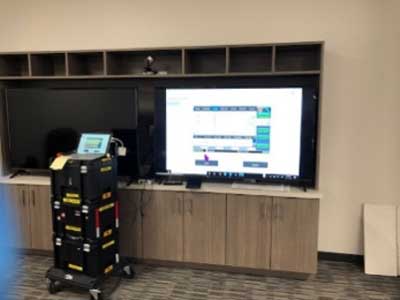
The instructor's laptop is connected to the OTDR and
projecting the display for everyone to see
The students when logged-in had control over the OTDR. Each
student saw the same screen which made the various events
much easier to explain. The module is very safe as the OTDR
is not touched by any student. The feedback we received from
the students was very positive. They provided suggestions
for future training modules. Even after the pandemic is
over, we will continue to use this new training method. Our
best teachers are our students and our hats are off to all
of our students.
For more information, contact Tom or Donna Collins at Techtricians.
FOA
School BDI
Datalynk is offering classroom training with Covid
precautions and remote classes over most of the US.
FOA
Master Instructor Eric Pearson of Pearson
Technologiesis now offering classroom training with
Covid precautions - 9/2020
Contact
Eric for details on his classes.
Classroom
Training Is Adapting To The Pandemic 8/2020
FOA
Director and instructor Tom Collins sent photos of his
recent IMSA/FOA CFOT class held in Florida. It shows how Tom
dresses for the job and how his students are social
distancing. More FOA classes are being held now using
techniques like these.
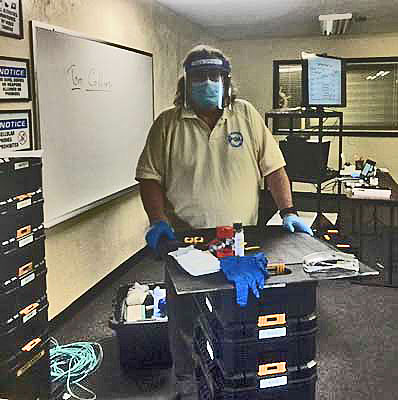
Instructor Tom Collins perpared to teach in the classroom.
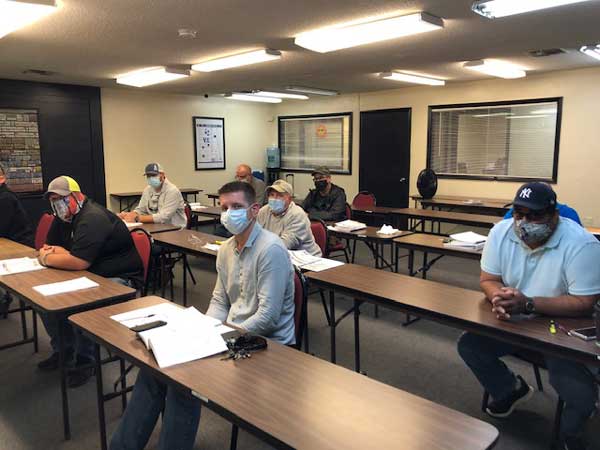
Students with appropriate distancing.
Training
Is Back - Made Safer (6/2020)
FOA
schools are starting to offer classes at their facilities
again to provide the personal interaction with an instructor
and hands-on labs, but some things have changed to provide
social distancing. Serge Rodrigue at Fibre
Zone in Quebec, Canada sent photos of his new lab
setup that includes individual lab stations with plexiglass
barriers.
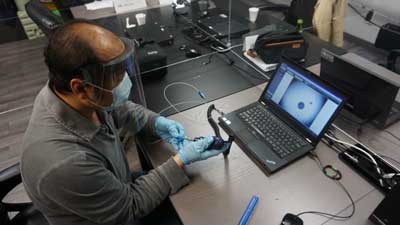
Students are following safe working protocols - masks and
gloves - to make classes safe and meet local government
requirements for social distancing.
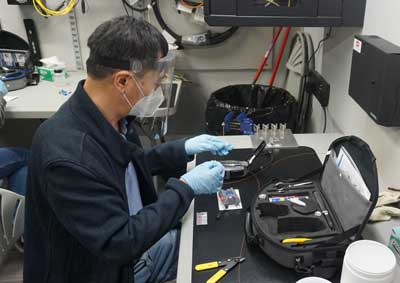
Contact Fibre
Zone in Quebec, Canada for
more information on their classes.
FiberNext in New Hampshire has also rearranged classrooms
for safer classes and has begun training in their facilities
in Concord, NH.
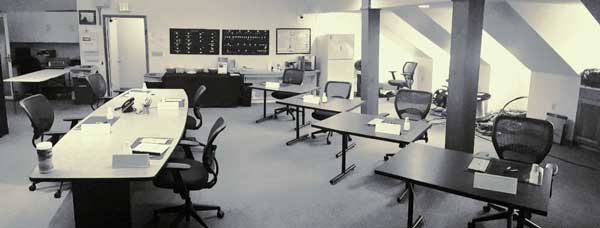
Contact FiberNext
in Concord, NH, USA or
more information on their classes. Also ask about joining
their CFOT
Club for savings on products and training.
DIY (Do-It-Yourself) Labs (6/20)
Knowledge
is easy to get online, but learning skills requires
"hands-on" practice and that requires tools and
components to practice with. Here at FOA, we've been
working on an online course that could help many
techs learn new skills or improve others using an
online self-study course and their own equipment. Recently,
we have updated the materials in the Fiber
U Fiber Optics Basic
Skills Labs which includes cable
preparation, splicing, termination and testing.
And we have created a Basic
Skills Labs - Copper Premises Cabling to
cover UTP (Cat 5) and coax copper cable
processes. As with all Fiber U courses, these
are free.
Several times in the FOA Newsletter we've discussed
the Fiber
U Basic Skills Lab. This online DIY lab course
assumes you have your own equipment to use for the
labs, but most novices, unless they work for a larger
company already in fiber optics, will not have
equipment. FOA instructors have found a solution:
purchase inexpensive equipment online. What they have
found are many low cost tools and components that are
perfectly suited to training.
If
you do not have tools or equipment and want to
purchase them, there is a new
Fiber U DIY Basic Skills Lab lesson with
directions on how to purchase inexpensive tools
online and use them to learn basic fiber optic
skills. Those tools and components are what we
describe here.
For example, you need a fiber cleaver
for splices and prepolished/splice connectors. A good
cleave is essential for a good splice or termination
with a splice-type connection. Good cleavers are now
available online at prices in the US starting at
$20US.
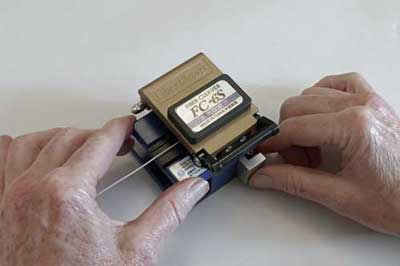
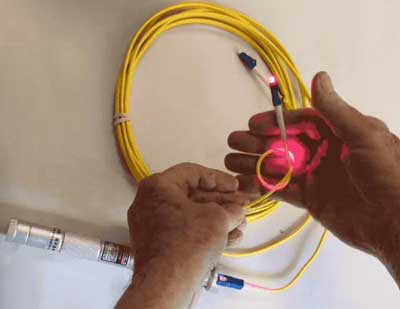
Besides the cleaver, another really good tool for
learning or teaching is a visual fault locator. These
devices used to be very expensive, but now are
available online for $10-20.
Many online sellers offer sets of fiber optic tools in
a kit for very low cost.
With plenty of tools available online, the next things
you need are components to practice on. No problem
here either. You need a patchcord, some mechanical
splices and some prepolished/splice connectors. The
connectors and splices are available from online
sellers for ~$1 each, easy to afford plenty to
practice on.
FOA has used all these available parts together into a
do-it-yourself
hands-on lab as part of the Fiber U Basic Skills
Lab. You can do this yourself at a very low
cost. We
even provide directions on how to search for
suppliers of these tools and components.
Caution!
FOA has not exhaustively tested these tools or
components enough to recommend them for field use. The
work we did with them to create teaching labs shows
they are certainly good enough to use for teaching the
installation processes in a training lab. We suggest
read the buyers reviews and do some of your own
testing before using them for anything other than
training and practice.
FOA
Guide "Basics Of Fiber Optics" Now Available Online in
Portuguese (6/2020)

FOA has
now translated the Basics of Fiber Optics textbook in our
Online Guide into Portuguese, joining Spanish and French
translations. For those speaking Portuguese, we have the
technical information and for schools we also have
curriculum available.
Here
is the FOA
Guide in Portuguese,
Spanish and
French
translations.
Time
To Learn - Online - (Update 4/5/6/8 2020)
Schools
have generally been closed during the pandemic lock-downs,
so FOA has been working with some of them to create new
online learning experiences that can in some cases lead to
certification online. FOA certifications are still based on
the KSAs - knowledge from the classroom, skills from the
labs and abilities judged by instructors or proven by actual
experience.
ZOOMing
Much of what we're doing benefits from the capabilities of
"Zoom." Others have created videoconferencing apps, but none
work so well, especially with limited bandwidth. We've seen
remote labs that have an instructor showing students how to
use the tools they were sent then watching them duplicate
their actions. We have worked out methods to use Zoom to
proctor FOA's online certification exams.
Blended
Learning
While most FOA schools have suspended in-person training
during this period, some are offering a "blended
learning" option. That means that students sign up for a
FOA certification course, take the classroom sessions on
Fiber U with the assistance of a FOA certified
instructor. Now online instruction can include reviewing
the labs using the Fiber
U Basic Skills Labs, then when it's possible to attend
classes at the school, complete the hands-on labs and
take the FOA certification exam.
Online Remote Labs
Alternatively, some schools are experimenting with
"remote labs," where the students get sent tool kits
and components and labs are conducted by
videoconferencing. Before the labs, the students may
watch demos by their instructor on videoconferencing
and/or review the relevant "virtual hands-on" lessons
in the Fiber U Fiber
Optics Basic
Skills Labs so they will already know
the steps in the exercises. And
Fiber U has the new
Fiber U DIY Basic Skills Lab lesson
with directions on how to purchase
inexpensive tools online and use them
to learn basic fiber optic skills. Videoconferencing
allows the instructor to remotely monitor their
work and provide help as needed. Contact
the FOA for more information.
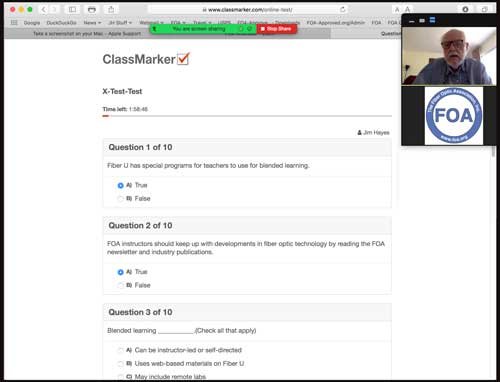
FOA Zoom Exam Proctoring
Online
Certification Testing
FOA has all its certification tests available
online, both for use by our schools and by our
direct "Work
to Cert" applicants. All FOA certification
tests require a proctor to oversee the applicant
taking the exam. In this time of social
distancing, getting a proctor can be difficult, so
FOA now has procedures for online proctors
administering the exam. Contact
the FOA for more information.
OJT - On-The-Job-Training
Many novices get a job and learn on the job. They
usually have an experienced tech who helps them gain the
knowledge and learn the skills they need to
perform their job. Thinking about this in relation to
the
FOA KSAs, the knowledge, skills and
abilities needed by a fiber optic tech, the tech
will learn skills but not the basic knowledge that helps
them understand the processes involved. FOA can offer
help here, using our Fiber
U online self-study programs. While the tech
learns on the job, they become a Fiber
U trainee, getting the knowledge they need,
while working under their "mentor" at work. This is
particularly good for contracting companies who need
techs but do not have the usual training courses
available. Interested in OJT programs? Contact FOA
for more information.
Can
You Learn Hands-On Skills Online?

Knowledge is easy to learn online, but learning skills
requires "hands-on" practice and that requires tools and
components to practice with. Here at FOA, we've been working
on an online course that could help many techs learn new
skills or improve others using an online self-study course
and their own equipment. Recently,
we have updated the materials in the Fiber
U Fiber Optics Basic
Skills Labs which includes cable preparation,
splicing, termination and testing. And we have created a
Basic
Skills Labs - Copper Premises Cabling to cover
UTP (Cat 5) and coax copper cable processes. As with
all Fiber U courses, these are free.

FOA offers free online self-study programs at Fiber
U. Many users are preparing for FOA certification
programs - taking courses at our schools or using the "Work-to-Cert"
program. Some of our schools are requiring Fiber U programs
as prerequisites for their classroom courses so they can
spend more time on hands-on activities.
New
FOA Approved School: Central
Electrical Training Center, FOA
School #656.
Find
a listing of all the FOA-Approved schools here.
FOA
School Offers Toolkit With Online Training
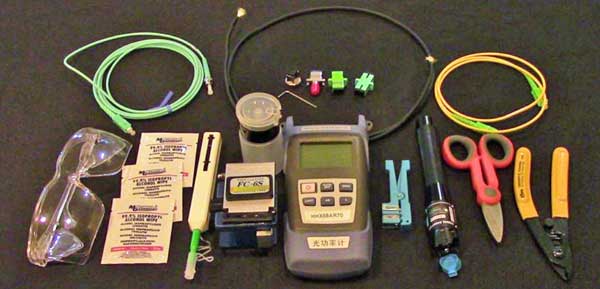
Slayton
Solutions (FOA Approved School #156) is offering a simple
fiber optic tool kit that includes a 29-piece set of fiber
optic tools and a power meter along with training videos
and online instruction for only $499. 29 Piece Kit
includes all tools and devices a technician needs to
install fiber optic connectors and test optical
power. Information
on the kit is available on YouTube.
You can contact them for more information at
slaytonsolutions@sbcglobal.net
or https://www.fiberopticsinstitute.com
|
Publications /
Resources

|
More
New FOA Video Lectures On YouTube
As part
of developing the new Fiber U MiniCourses, we added several
new YouTube videos:
Lecture 56 explains the issues of cable bend radius
limitations, typical cable specifications and how to gage
the proper radius or diameter when installing or storing
cable. Lecture 57 covers problems with dirty connectors and
how to inspect and clean them.
Videos
added last month:
FOA
Lecture 51 Fiber Optic Restoration
Part 1 - Causes of Damage To The
Network
FOA
Lecture 52 Fiber Optic Restoration Part 2 -
Planning For Restoration
FOA
Lecture 53 Fiber Optic Restoration Part 3 -
Troubleshooting And Repair
FOA
Lecture 54 Fiber Optic Connector Identification
- New and old
FOA
Lecture 55 The Mysterious dB of Fiber Optics.
- Understanding dB
FOA
Lecture 56 Fiber Optic Cable - Bend Radius
- Important for Installers to Understand
Lectures 51, 52 and 53 are about fiber optic
network restoration, broken into 3 parts: what
causes damage, how to plan for restoration and
finally troubleshooting and repairing a network
outage. Lecture 54 is a short history of the
development of fiber optic connectors and a
overview of the ones most used today. Lecture 55
will teach you about dB, it's origin, an
explanation of the math behind it and why
standards can make it confusing. Lecture 56
explains fiber optic cable bend radius limits and
reduces the confusion over radius and diameter.
Lecture 57 is a quick tutorial on cleaning and
inspecting connectors. Lecture 58 is about
converting fiber to copper or multimode to
singlemode fiber.
Like all our YouTube lectures, they are all short
and easy to understand.
FOA
Loss Budget Calculator On A Web Page 5/2020
FOA has
written many articles about loss budgets, something everyone
involved in fiber optics needs to know and needs to know how
to calculate. We recently discovered how to get a
spreadsheet ported to a Web page, so we created this web
page that calculates loss budgets. We have an iOS loss
budget app, but with this web page, you can calculate loss
budgets from any device, smart phone, tablet, laptop, or
desktop computer that has web browsing capability.

Bookmark this page (especially on your smartphone): FOA
Loss Budget Calculator Online
 We are
continually updating the Online Reference Guide to keep up
with changes in the industry and adding lots of new pages of
technical information. When you go to the FOA
Guide Table of Contents to see the latest updates -
look for
We are
continually updating the Online Reference Guide to keep up
with changes in the industry and adding lots of new pages of
technical information. When you go to the FOA
Guide Table of Contents to see the latest updates -
look for  . .
Recent updates:
10GPON
on PON Protocols in the FOA Guide.
Coherent
Communications Systems in the FOA Guide.
Updated
(and more illustrations): Basic
Fiber Optic Jargon, OSP
Fiber
Optic Jargon and Fiber
Optic Jargon for managers.
Fiber
Optic Network Restoration
Fiber
Characterization goes in to more depth, why fiber
characterization is important and how to interpret results.
Fiber
Optic Network Management for managers
FOA
has created a section on OSP
Construction and a Fiber
U course based on it.
FOA
Guide section on inspecting and cleaning connectors.
Go
to The
FOA Online Fiber Optic Reference Guide.
FOA Reference Books
Available Printed or Kindle Books
The
fiber book is available in Spanish and French (printed) and
Portuguese (online). The design book is available in Spanish
(online)








FOA has
reprinted "Lennie
Lightwave's Guide" on its 25th anniversary in
a special print edition.
Lennie
and Uncle
Ted's Guides are online or as free iBooks on iTunes.


Click
on any of the books to learn more.
- Fiber
Optic Safety Poster to download and print
Resources
For Teachers In K-12 And Technical Schools
Teachers in all grades can introduce their students to
fiber optic technology with some simple demonstrations.
FOA has created a page for STEM or STEAM (science,
technology, engineering, arts
and math) teachers with materials appropriate to their
classes. Fiber
Optic Resources For Teachers.
|
Safety
|
On
Safety
FOA
considers safety an integral part of all our programs,
curriculum materials and technical materials. We start all
our textbooks and their online versions with a section on
safety in the first chapter, like this: Before
we get started - Safety First!
There are pages on the FOA Guide on Safety
procedures Including Eye Safety and. Digging
Safely
And a YouTube lecture: FOA
Lecture 2: Safety When Working With Fiber Optics
In our OSP Construction Section, these pages cover many
safety issues including those related to the construction of
the cable plant: Project
Preparation And Guidelines, Underground
Cable Construction, Underground
Cable Installation and Aerial
Cable Installation.
There is even a safety poster for the fiber activities: PDF
Safety Rules For Fiber Optics
The FOA is concerned about safety!
There
is a toll-free "call before you dig" number in the USA:
Dial 811
See
www.call811.com for
more information
The
Common Ground Alliance has an excellent "Best
Practices Guide" online
- The
US Department of Transportation has a website called "National
Pipeline Mapping System" that allows one to
search for buried pipelines.
Why
We Warn You To Be Careful About Fiber Shards
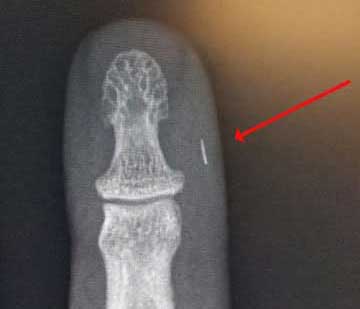
Photo courtesy Brian Brandstetter, Mississauga
Training Consultantcy
Safety
Leader Magazine
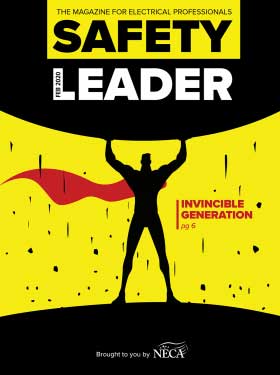
Safety Leader, a new quarterly magazine, informs and
educates electrical contractors on safety from various
angles—electrical, workplace, PPE, regulations, leadership,
line work, NFPA 70E, and more. Safety Leader is bundled with
ELECTRICAL CONTRACTOR in February, May, August and November.
To receive Safety Leader subscribe
to ELECTRICAL CONTRACTOR magazine here or subscribe
to the ELECTRICAL CONTRACTOR newsletter here.
2021
Conference On Damage Prevention Goes Virtual

2021
Global
Excavation Safety Conference VIRTUAL, taking
place April 6-8, 2021
More information in an article
in the dp-PRO announcing the Global Locate
Masters:
Website: www.GlobalLocateMasters.com
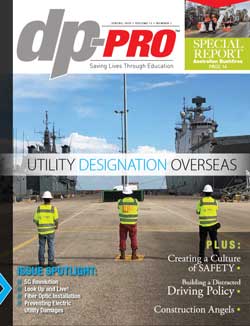
The magazine, dp-Pro, sponsor of the conference, has
also published it's latest issue with an article by FOA
on "New Construction Techniques in Fiber Optics" and a
overview of the FOA. You
can read the magazine here.
Best
Practices Guide For Underground Construction
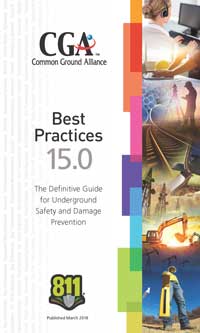
We
assume you are familiar with the "One Call" and "Call
Before You Dig" (811) program, but are you also
familiar "Click
Before You Dig.com" and with the people behind
it - the Common Ground Alliance and their Best Practices
website?
Officially
formed in 2000, the CGA represents a continuation of the
damage prevention efforts embodied by the Common
Ground Study.
Sponsored by the U.S. Department of Transportation and
completed in 1999, this Study represents the collaborative
work of 160 industry professionals who identified best
practices relating to damage prevention. Any
best practice or program endorsed by the CGA comes with
consensus support from experts representing the
following stakeholder groups: Excavators, Locators, Road
Builders, Electric, Telecommunications, Oil, Gas
Distribution, Gas Transmission, Railroad, One Call,
Public Works, Equipment Manufacturing, State Regulators,
Insurance, Emergency Services and Engineering/Design.
Read
the CGA Best Practices Guide here.
Here
are all the CGA resources for damage prevention.
The
US Department of Transportation has a website called "National
Pipeline Mapping System" that allows one to search
for buried pipelines. |
FOA/About
About
The FOA
- Contact
Us: http://www.foa.org
or email <info@foa.org>

FOA
has a company page and four LinkedIn Groups
FOA
- official company page on LinkedIn
FOA
- covers FOA, technology and jobs in the fiber optic
marketplace
FOA
Fiber Optic Training - open to all, covers fiber optic
technology and training topics
Grupo
de La Asociación de Fibra Óptica FOA (Español)
|
What is The FOA?
The FOA is a, international non-profit educational
association chartered to promote professionalism in fiber
optics through education, certification and standards.
Founded in 1995 by a dozen prominent fiber optics trainers
and leaders from education, industry
and government as
a professional society for fiber optics and a source of
independent certification, the FOA has grown to now being
involved in numerous activities to educate the world about
fiber optics and certify the workers who design, build and
operate the world's fiber optic networks.
FOA
is 25 years old this July - read about FOA's history in
this newsletter above.
Learn
More About FOA's History.
Contact
Us
The Fiber Optic Association Inc.
http://www.foa.org or email
<info@foa.org>
The
FOA Home Page

Want
to know more about fiber optics? Study
for FOA certifications? Free
Self-Study Programs are on "Fiber
U®." Looking for specific information? Here's the
largest technical reference on the web: The
FOA Online Fiber Optic Reference Guide.

Free
online self-study programs on many fiber optics and cabling
topics are available at Fiber
U, FOA's online web-based training website.
|
-
Contact
Us
The Fiber Optic Association Inc.
http://www.foa.org or email
<info@foa.org>
- Phone:
1-760-451-3655
The
FOA Home Page
(C)1999-2020,
The Fiber Optic Association, Inc.
|
FOA
Logo Merchandise
New
FOA Swag! Shirts, Caps, Stickers, Cups, etc.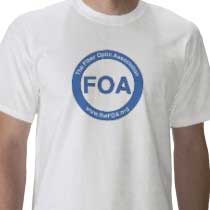
The FOA
has created a store on Zazzle.com offering lots of new logo
merchandise. It has lots of versions of shirts and other
merchandise with "FOA," "Fiber U," "Lennie Lightwave"
designs and more so you should find something just for you!
See FOA
on Zazzle.
-
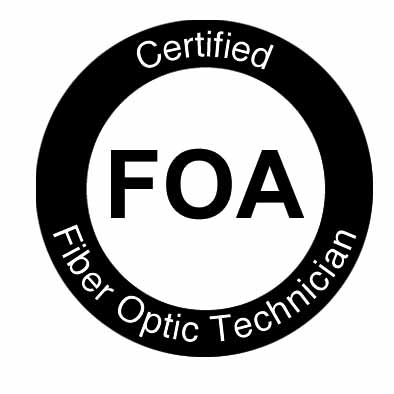
Your
Name, CFOT® - It pays to advertise!
The
FOA encourages CFOTs to use the logo on their business
cards, letterhead, truck or van, etc. and provides logo
files for that purpose. But we are also asked about how to
use the CFOT or CFOS certifications. Easy, you can refer
to yourself as "Your Name, CFOT" or "Your Name, CFOS/T"
for example.
Feel
free to use the logo and designations to promote your
achievements and professionalism!
Contact
FOA at info@thefoa.org to get logos in file format for your
use.
Privacy
Policy (for the EU
GDPR): The FOA does not use cookies or any other
web tricks to gather information on visitors to our
website, nor do we allow commercial advertising. Our
website hosts may gather traffic statistics for the
visitors to our website and our online testing service,
ClassMarker, maintains statistics of test results. We do
not release or misuse any information on any of our
members except we will confirm FOA certifications and
Fiber U certificates of completion when requested by
appropriate persons such as employers or personnel
services.
Read
the complete FOA Privacy Policy here.
|
























 Google
photo
Google
photo

















































 .
.





